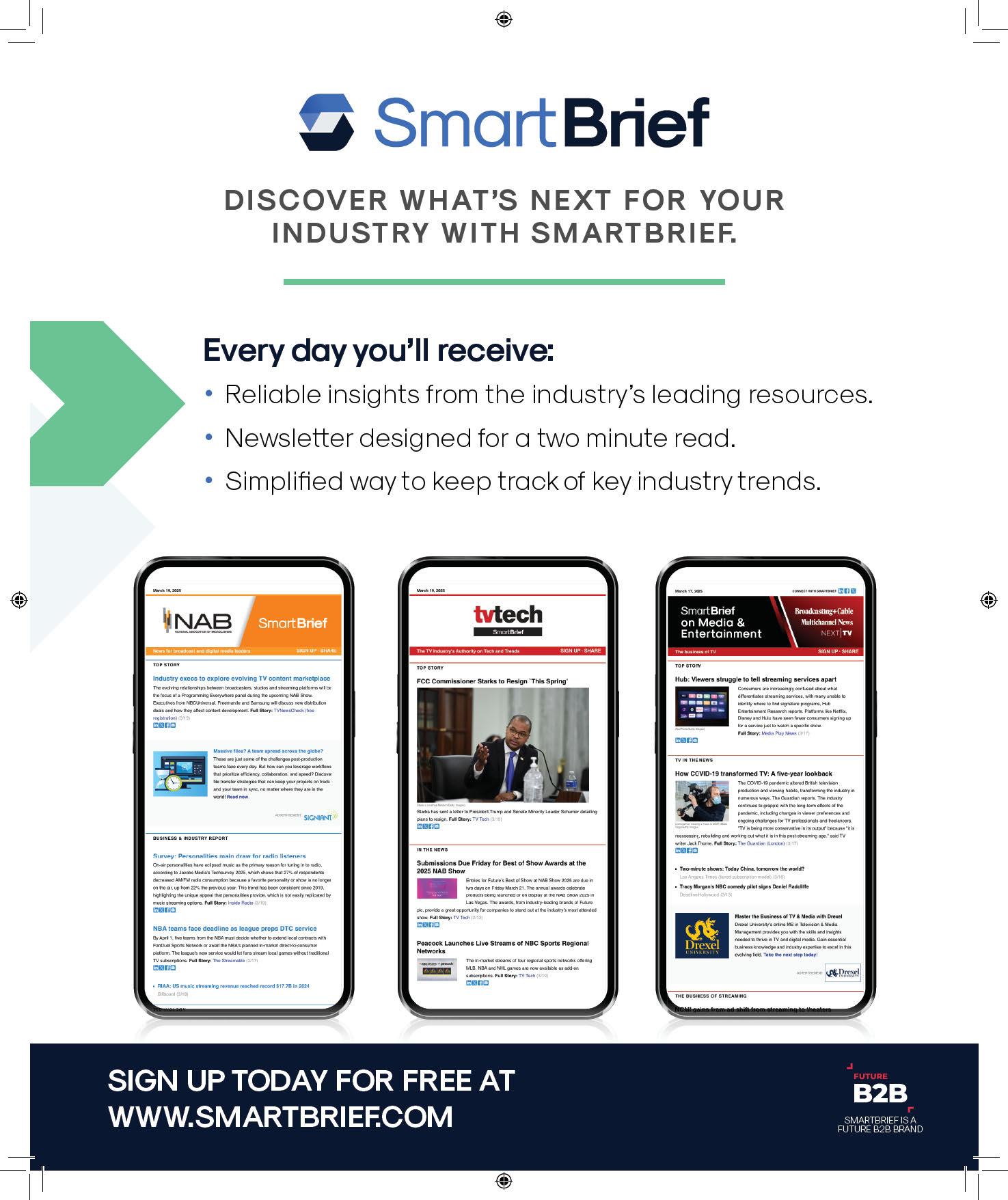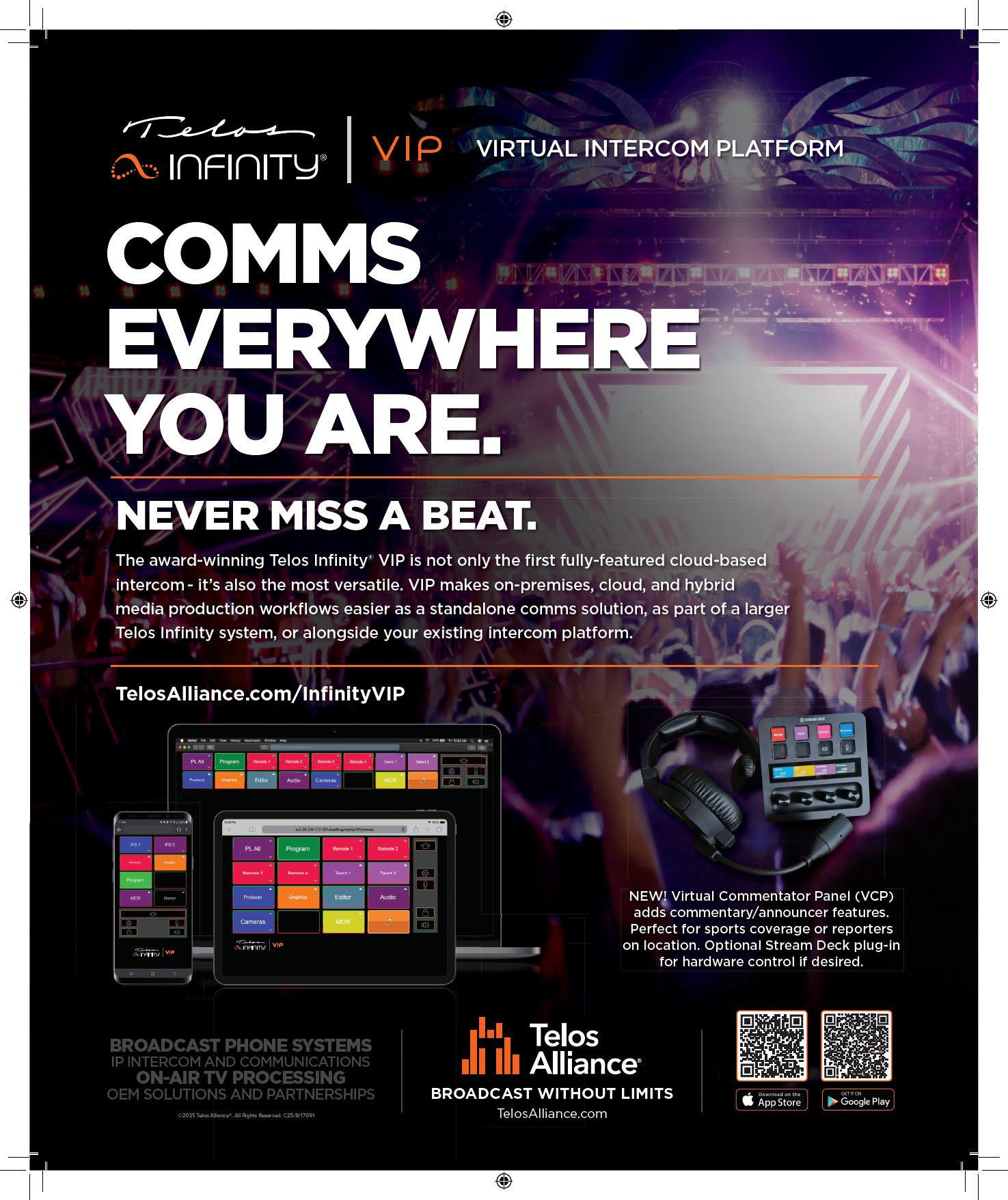Welcome to the June 2025 issue of

















Make quick, precise audio adjustments from anywhere, any time. Complement your news automation system with this virtual mixer.





Adjust the occasional audio level with the Virtual Strata mixer as an extension of your production automation system. Mix feeds and manage the entire audio production with all the mix-minus, automixing, control and routing features you need from your touchscreen monitor or tablet. Fits in any broadcast environment as an AES67/SMPTE 2110 compatible, WheatNet-IP audio networked mixer console surface
Connect with your Wheatstone Sales Engineer Call +1 252-638-7000 or email sales@wheatstone.com



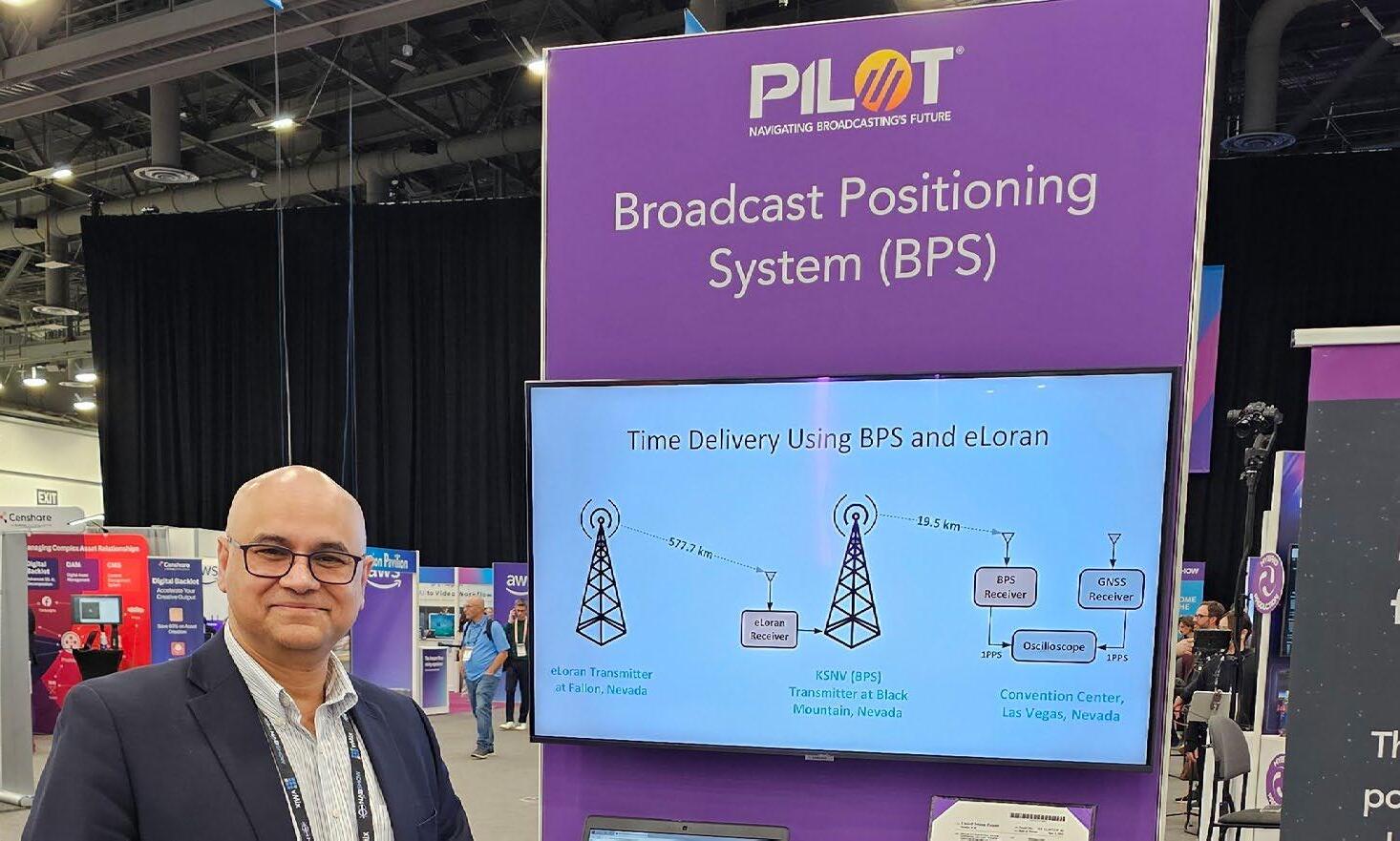

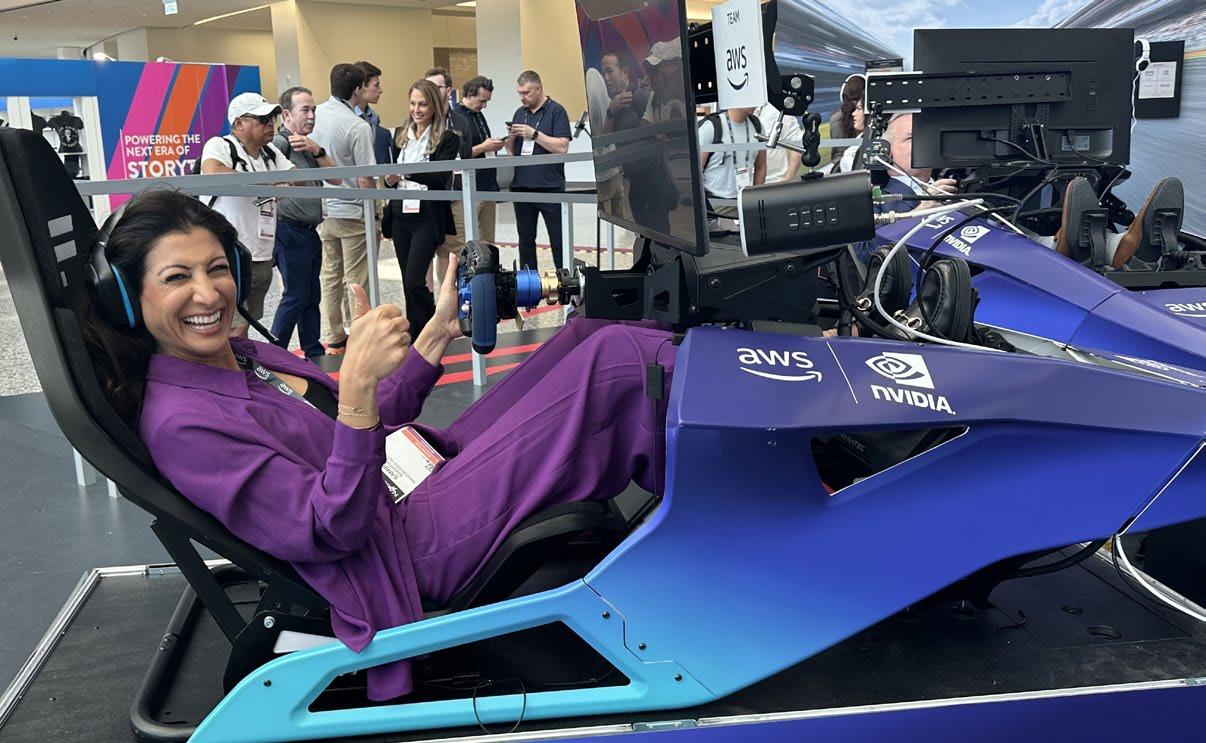

James Careless
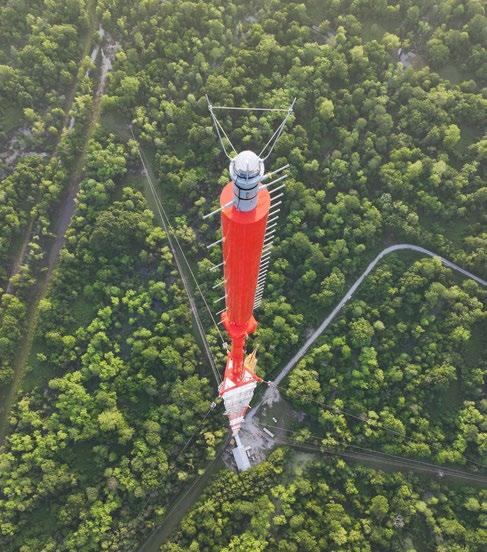
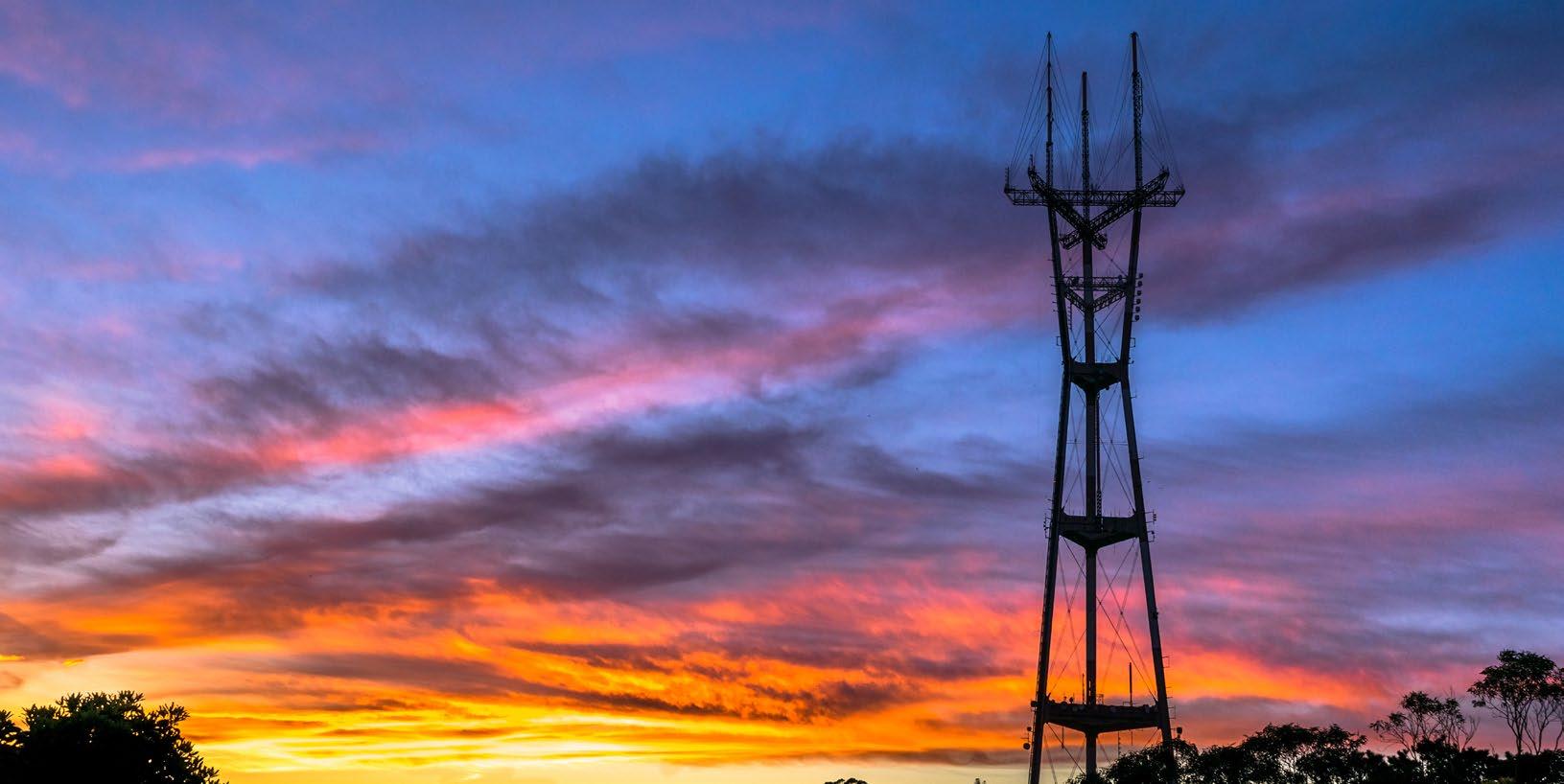
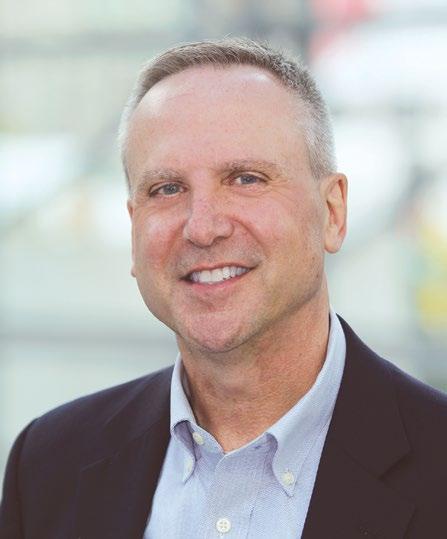
In the ongoing transition to ATSC 3.0, the broadcast industry is seeking an end to ATSC 1.0, asking the Federal Communications Commission to set deadlines for shutting it down in the top 55 markets by 2028, with the remaining markets to cease 1.0 by 2030.
Such a bold move doesn’t come without inherent risks. In the past month or so, comments have been filed with the FCC; currently, the number is more than 6,000 and counting, with the closing date of June 6.
Perusing the comments has provided an interesting window into how various industry groups view the transition. Broadcasters are mainly concerned with maintaining a healthy business in a time of increasing competition from “Big Tech”—including streaming services that are chipping away at traditional broadcasters’ marquee programming (i.e. live sports).
Public broadcasters—their very existence under assault by the Trump administration (and Congress)—are concerned about the continued availability of broadcasts once 1.0 is shuttered.
Mississippi Public Broadcasting told the FCC that “it is concerned about the availability of affordability of ATSC 3.0-ready devices for low-income and disadvantaged communities in the state.”
That availability includes not only traditional NextGen TV sets sold in the U.S., but the smallbut-growing number of low-cost dongles and boxes that support ATSC 3.0.
And by “support,” we mean full support, including DRM (digital rights management).
Remember Napster? Broadcasters certainly do, and in order to protect their content from being pirated, ATSC 3.0 allows stations to encrypt channels accessed by devices that don’t fully support the A3SA 3.0 security protocol. But judging by the uproar by a small but vocal minority of viewers on social media who believe that “free to watch,” also means “free to record and distribute,” you would think that the problem is widespread and threatens the very future of broadcast television.
It isn’t and it won’t. The angst seems to be driven by a handful of devices that don’t comply with A3SA and the manufacturers have yet to upgrade their software; meanwhile, every TV set and device with the NextGen TV logo sold in the U.S. is certified to comply with the encryption protocol.
Sinclair told the commission: “There are few issues in the history of ATSC 3.0 proceedings that have generated as much heat and as little light as DRM, an issue that is as misunderstood as it is overstated. DRM is common throughout the video ecosystem, used in streaming and cable, including most ad-supported services, to protect high-value content.”
But not all broadcasters are on board. Weigel Broadcasting told the commission that “DRM deployment for ATSC 3.0 signals has already been recognized by consumers as hindering the functionality of televisions and converter boxes.” While acknowledging that the commission has received “thousands of consumer comments” about the problem, Weigel said it further opposes the use of DRM “to collect payments for either content or functionality that broadcasters now offer for free.”
Vol. 43 No. 6 | June 2025
FOLLOW US www.tvtech.com twitter.com/tvtechnology
CONTENT
Content Director
Tom Butts, tom.butts@futurenet.com
Content Managers
Michael Demenchuk, michael.demenchuk@futurenet
Senior Content Producer
George Winslow, george.winslow@futurenet.com
Contributors: Gary Arlen, James Careless, Fred Dawson, Kevin Hilton and Phil Rhodes
Production Managers: Heather Tatrow, Nicole Schilling
Art Directors: Cliff Newman, Steven Mumby
ADVERTISING SALES
Managing Vice President of Sales, B2B Tech
Adam Goldstein, adam.goldstein@futurenet.com
Publisher, TV Tech/TVBEurope
Joe Palombo, joseph.palombo@futurenet.com
SUBSCRIBER CUSTOMER SERVICE
To subscribe, change your address, or check on your current account status, go to www.tvtechnology.com and click on About Us, email futureplc@computerfulfillment.com, call 888-266-5828, or write P.O. Box 8692, Lowell, MA 01853.
LICENSING/REPRINTS/PERMISSIONS
TV Technology is available for licensing. Contact the Licensing team to discuss partnership opportunities. Head of Print Licensing Rachel Shaw licensing@futurenet.com
MANAGEMENT
SVP, MD, B2B Amanda Darman-Allen VP, Global Head of Content, B2B Carmel King MD, Content, Broadcast Tech Paul McLane Global Head of Sales, Future B2B Tom Sikes VP, Global Head of Strategy & Ops, B2B Allison Markert VP, Product & Marketing, B2B Andrew Buchholz Head of Production US & UK Mark Constance Head of Design, B2B Nicole Cobban FUTURE US, INC. 130 West 42nd Street, 7th Floor, New York, NY 10036

and
Quay House, The Ambury, Bath BA1 1UA. All information contained in
Please Recycle. We are committed to only using magazine paper which is derived from responsibly managed, certified forestry and chlorine-free manufacture. The paper in this magazine was sourced and produced from sustainable managed forests, conforming to strict environmental and socioeconomic standards. TV Technology (ISSN: 0887-1701) is published monthly by Future US, Inc., 130 West 42nd Street, 7th Floor, New York, NY 10036-8002. Phone: 978-667-0352. Periodicals postage paid at New York, NY and additional mailing offices. POSTMASTER: Send address changes to TV Technology, P.O. Box 848, Lowell, MA 01853. Credit:XXXXXXXXXXXXXXXXXXXXXXXXX
Judging by the response so far, the debate over shuttering 1.0 has just started and is expected to become more animated as the broadcast industry weighs the advantages of bringing enhanced services to viewers via 3.0 vs. the need to protect content and compete in today’s crowded media market.
Tom Butts Content Director
tom.butts@futurenet.com
is for information only and is, as far as we are aware, correct at the time of going to press. Future cannot accept any responsibility for errors or inaccuracies in such information. You are advised to contact manufacturers and retailers directly with regard to the price of products/services referred to in this publication. Apps and websites mentioned in this publication are not under our control. We are not responsible for their contents or any other changes or updates to them. This magazine is fully independent and not affiliated in any way with the companies mentioned herein. If you submit material to us, you warrant that you own the material and/or have the necessary rights/permissions to supply the material and you automatically grant Future and its licensees a licence to publish your submission in whole or in part in any/all issues and/or editions of publications, in any format published worldwide and on associated websites, social media channels and associated products. Any material you submit is sent at your own risk and, although every care is taken, neither Future nor its employees, agents,subcontractors or licensees shall be liable for loss or damage. We assume all unsolicited material is for publication unless otherwise stated, and reserve the right to edit, amend, adapt all submissions.

Morgan Murphy Media issued the following obituary for its former CEO: Morgan Murphy Media announces with profound sadness the passing of Elizabeth Murphy Burns, the company’s longtime president and CEO, who led the family-owned media company for 43 years. She was 79.
Murphy Burns, who in March stepped down as CEO to become chair of the company’s board of directors, was a pioneering figure in American broadcasting who transformed her family’s business into a multiplatform media company while breaking barriers for women in the industry.
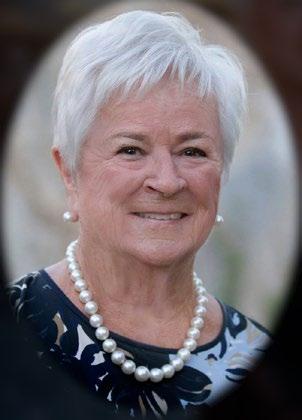
Murphy Burns began her career at age 14, selling classified ads for her family’s newspaper. After attending the University of Arizona, she entered broadcasting and owned and operated a radio station by age 25 before rejoining her family’s management team. In 1982, she became vice president of what would later become Morgan Murphy Media, leading the company with her brother John Murphy.

“Elizabeth Murphy Burns was a visionary leader whose influence extended far beyond our company,” said Brian Burns, who was appointed by Murphy Burns as president and CEO last month. “Her commitment to journalistic integrity, technological innovation, and community service shaped not only Morgan Murphy Media but the entire broadcasting industry. Her legacy will continue to guide us as we move forward.”
Born into a family of media pioneers,
Under her stewardship and partnership with her brother, the newspaper business founded by her grandfather in 1890 and expanded by her father grew to include broadcast television stations in eight markets with affiliations with all major networks, 17 radio stations, a monthly magazine and a digital agency.
“Liz Burns was a trailblazer, a fierce advocate for local broadcasting and a dear friend to me and so many in our industry,”
NAB President and CEO Curtis LeGeyt said. “Through her visionary leadership at Morgan Murphy Media and her tireless work with NAB, Liz left an indelible mark on broadcasting that will endure for generations.”
As Hollywood tries to digest the potential impact of President Donald Trump’s proposal to impose tariffs on foreign-produced films, Netflix has broken ground on a major new state-of-the-art production facility in Fort Monmouth, N.J.
Netflix plans to invest $1 billion to transform the 292-acre former U.S. Army installation into a premier East Coast production hub. The development will feature 12 cutting-edge sound stages totaling nearly 500,000 square feet,
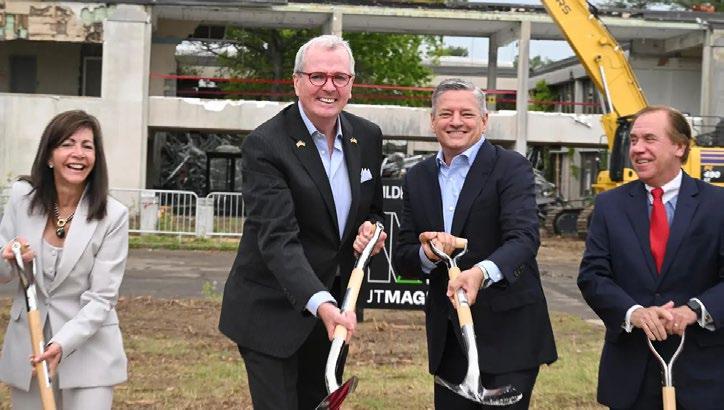
with additional areas dedicated to supporting film uses and community amenities.
“Netflix is proud to invest in American innovation and the creative community,” said Ted Sarandos, co-CEO of Netflix, who attended the groundbreaking ceremony on May 13. “We estimate that these studios will create thousands of jobs for New Jersey residents, billions of dollars in economic output, and many other cultural benefits to the region and state. Over the past four years, Netflix has contributed $125 billion to the U.S. economy and hired more than 140,000 cast and crew members. And we’re excited to continue our investment in the U.S. and New Jersey in the coming years.”
In 2022, Netflix announced plans to transform Fort Monmouth, a property that had been largely vacant for over a decade, into a production facility that local political leaders hope will become an important engine of economic growth. The project is expected to create a substantial number of permanent production jobs and construction-related positions.
Los Angeles Rams owner E. Stanley Kroenke has announced plans to develop a massive state-of-the-art movie studio and production facility called Hollywood Park Studios. The facility, being developed as part of the 300-acre mixed-use destination in Inglewood, California, will initially be used to host the International Broadcast Center during the 2028 Los Angeles Summer Olympics.
As the host site of the IBC for the 2028 Olympic and Paralympic Games, Hollywood Park Studios will house hundreds of media rightsholders from around the world who have acquired exclusive rights to distribute the coverage of the Games.
The IBC will offer broadcasters space for offices, studios and control rooms, as well as other services that will be used to deliver broadcast and digital Olympics and Paralympics coverage. Following the Games in 2028, HPS will be available for use for studio production and operations.
“The vision for Hollywood Park has always been to build a city within a city combining media, entertainment and technology that will transform the greater Los Angeles area,” Kroenke says. “We are thrilled to expand the role we will play in the 2028 Olympic and Paralympic Games by hosting the International Broadcast Center and the global media outlets who will call it home during that summer. Beyond 2028, Hollywood Park Studios will be open to welcome a new industry to our live, work, play destination and bring a little bit of Hollywood to Hollywood Park.”
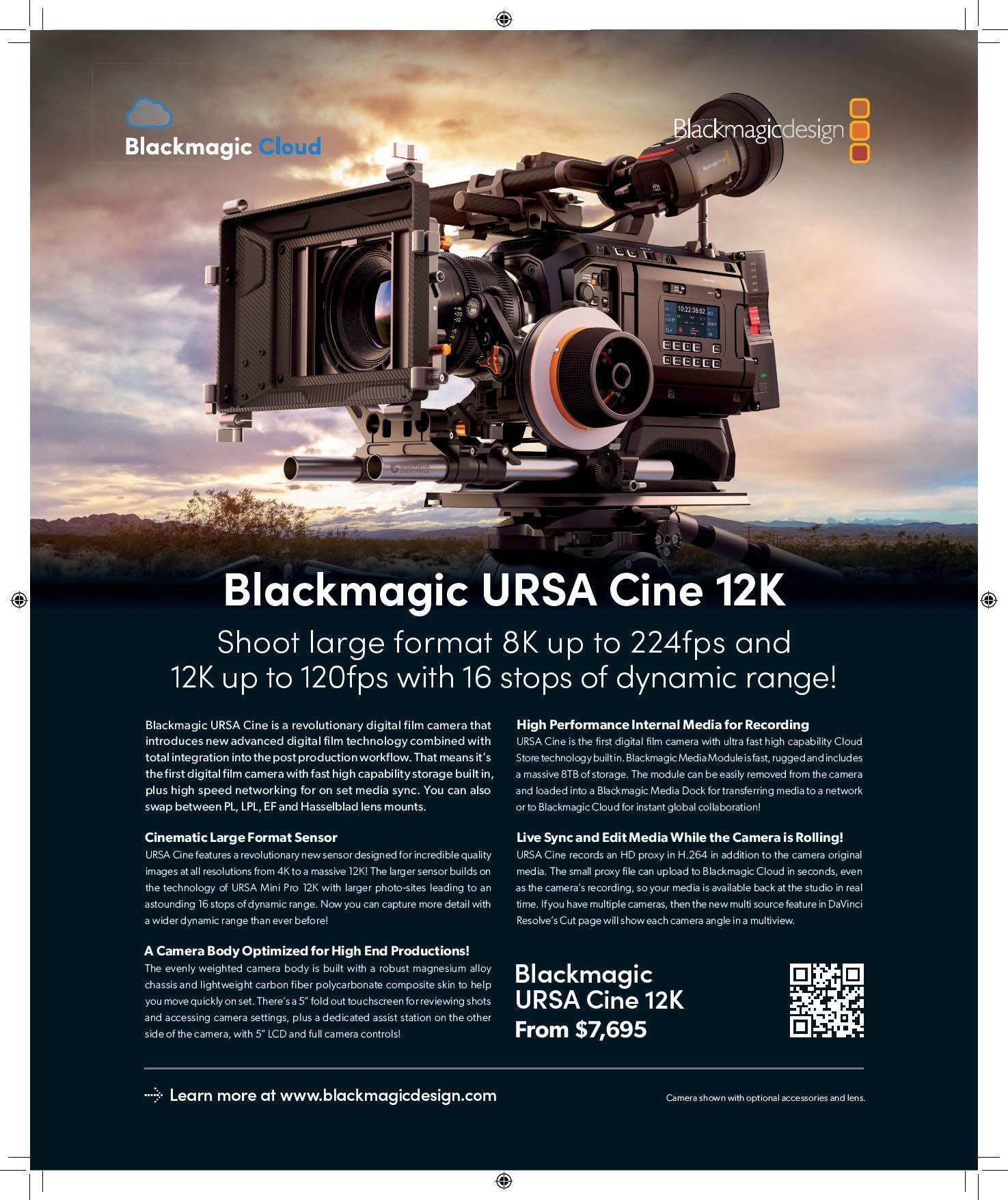
CHARLOTTE, N.C.—One of the most striking developments to emerge at the 2025 Golfweek Tech Lab gathering here May 15 at the J.W. Marriott was the laser-like focus placed by several startup tech firms, the venture capital community and the PGA Tour itself on fan engagement technology.
Companies like Bleachr, Cue, Mobii and PlayANYWHERE showed the 90 attendees their unique spins on elevating the experience of fans engaging with golf and other sports via their smartphones and other connected devices.

Phil Kurz
Not to be outdone, the PGA Tour is pursuing its own fan engagement strategy. “One of the big cultural shifts over the past five or six years is meeting the fans where they are,” says Scott Gutterman, senior vice president, Digital & Broadcast, for the PGA Tour, noting the tour is “getting closer and closer to the personalization … that people want.”
Speaking during a fireside chat on the way technology is being used to capture a younger audience, Gutterman discussed how the PGA Tour is using AI platforms to “tell a story about every shot”—no small feat, given the 30,00032,000 shots made during a typical tour event.
Each of those mini-stories will ultimately serve as the foundation of a service that delivers highlights to fans of their favorite players on their smartphones “when they’re running around town going to [kids’] soccer games, but they want to keep up,” he said.
Of course, the PGA Tour already relies on a variety of digital platforms, ranging from streaming via ESPN+ to distributing highlights via TikTok, to keep fans engaged with daily play as tournaments unfold.
“When I first arrived at the Tour [20 years ago], the rule was to get people to watch three hours of golf every single day,” Gutterman said. “Now really our stance on this has changed. How do we bring fans to the PGA Tour in any way? How do we meet fans where they are?”
What enables this innovation to drive deeper fan engagement? It would seem to be the same thing responsible for the countless other innovations that improve the lives of people in this country: freedom and the desire to profit. But what about television broadcasters?
Are they free to leverage the latest technologies to deliver the same sorts of personalized experiences with the content they broadcast to engage their “fans,” the viewers, more deeply and unlock new sources of revenue?
Enter Federal Communications Commission Chairman Brendan Carr’s Delete, Delete, Delete deregulation initiative. The public notice announcing it said in part: “The Communications Act directs the FCC to regularly review its rules to identify and eliminate those that are unnecessary in light of current circumstances, recognizing that in addition to imposing unnecessary burdens, unnecessary rules may stand in the way of deployment, expansion, competition and technological innovation in communications that the Commission is directed to advance.”
Setting aside comments and reply comments filed at the agency with regards to NAB’s rulemaking petition aimed at having the agency establish dates certain for the ATSC 1.0 shutoff, I can’t help but read that quote and think about how rules are standing in the way of broadcasters’ “deployment, expansion, competition, and technological innovation.”
Some in this industry seem to be most interested in delete, delete, delete when it comes to ownership rules. But for the long-term health of the industry, it is equally important that the agency eliminate rules stifling tech innovation.
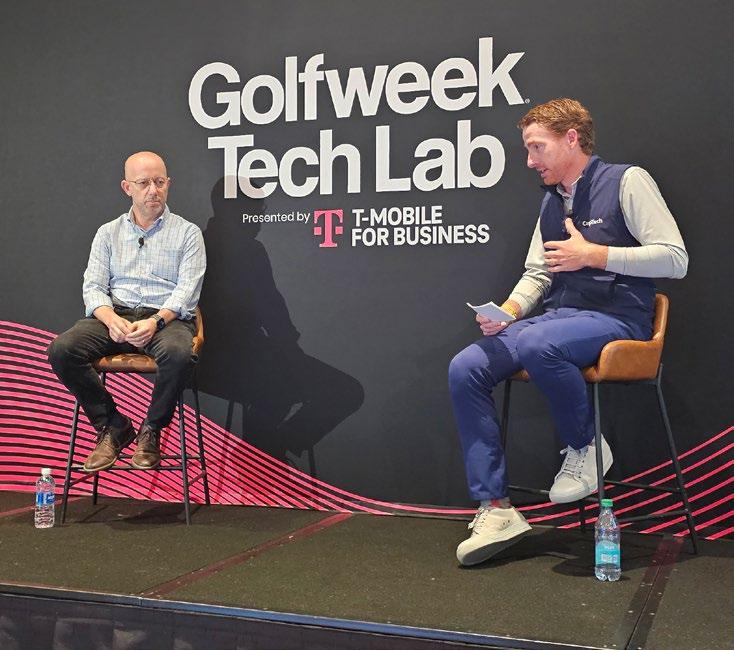

T-Mobile says it set a new uplink speed record of 550 Megabits per second in sub-6 GHz spectrum using cutting-edge 5G Advanced tech. The live demo, with Nokia and MediaTek, took place at a real commercial site in Seattle. The demo was the first in the world to set a speed record using Release 17 UL Tx Switching.
The news is notable because the broadband industry has traditionally focused on download speeds. But, as future applications become more interactive, real-time and cloud-connected, uplink speeds become increasingly important.
Potential customers for offerings with very fast upload speeds include content creation and gaming.
“Everyone obsesses over download speed, but at T-Mobile we see what’s coming, and uplink is the next big thing,” said Ulf Ewaldsson, president of technology, T-Mobile. “Whether you’re uploading 4K video, gaming in real time or powering a VR headset, this record shows that T-Mobile is already building the network for that future and focused on bringing the best customer experience.”
T-Mobile achieved this record-breaking 5G Advanced uplink speed by implementing the 3GPP Release 17 UL Tx Switching feature. This feature provides smart multiplexing to maximize user throughput on available device Tx chains by optimizing the use of UL Carrier Aggregation and UL MIMO for TDD and FDD spectrum.
T-Mobile used 100 MHz of TDD spectrum (n41) and 35 MHz of FDD spectrum (n25) in its live network demonstration to achieve the record-breaking 550 Mbps total speed. The test was conducted using a MediaTek smartphone flagship test device with an integrated M90 modem.

As station deployments stall, the industry looks to government, enterprise for expansion opportunities
By Tom Butts
As U.S. broadcasters mark nearly a decade of development and deployment of the ATSC 3.0 advanced broadcast standard (aka NextGen TV), the industry is seeking ways to expand interest and generate revenues beyond traditional television consumer applications.
Coinciding with this direction are recent moves to allow for the shutdown of ATSC 1.0 by February 2028 in the top 55 markets and February 2030 for the remaining markets.
“As competitive pressures mount, completing the transition to ATSC 3.0 expeditiously is essential for the future of the industry,” the National Association of Broadcasters said in a petition filed with the Federal Communications Commission at the end of February.
“Without decisive and immediate action, the transition risks stalling and the realistic window for implementation could pass. Reaching the finish line requires industry-wide coordination and engagement—something individual broadcasters cannot do alone. The FCC must now establish a clear timeline to complete the transition, just as it did when the industry and consumers migrated from analog to digital.”
‘UNLOCK THE FULL POTENTIAL’
“Sunsetting” ATSC 1.0 was top of mind at the 2025 NAB Show, with the FCC issuing a Notice of Inquiry asking for public comment to NAB’s petition on the second day of the convention.
“[FCC] Commissioner [Anna] Gomez was in our booth at that moment and got the ping on her watch that the public notice had hit,” says Madeleine Noland, president of the Advanced Television Systems Committee (ATSC). “Nobody knew that was going to happen during the show, and so I think it was the petition itself that got people really interested to understand what was going to happen next.”
With broadcasters required to simulcast 1.0 and 3.0—most of them sharing transmission
facilities in the 80 markets that have deployed NextGen TV (covering approximately 76% of the country)—they’re eager to take full advantage of the full 6-MHz band.
“A complete transition is essential to unlock the full potential of ATSC 3.0, which cannot happen until the entire industry moves off ATSC 1.0 and reclaims that spectrum,” the NAB told the FCC. “Without this shift, broadcasters are forced to split their finite spectrum between the two standards, limiting the bandwidth available for ATSC 3.0’s most advanced capabilities and harming consumers in the process.”
While not specifically tying the sunset of ATSC 1.0 with what it says are “outdated” ownership regulations, the NAB is also seeking an update to the rules that would allow the industry to better compete with “Big Tech.” And naturally, given the advanced features offered by NextGen TV—4K, immersive audio and personalization (among others)—allowing broadcasters to deploy these enhancements will be less burdensome without 1.0.
Booth traffic to the ATSC’s stand in the West Hall this year was up 30%, Noland says, and much of that was driven by Brazil’s landmark decision to adopt the ATSC 3.0 standard in 2024.
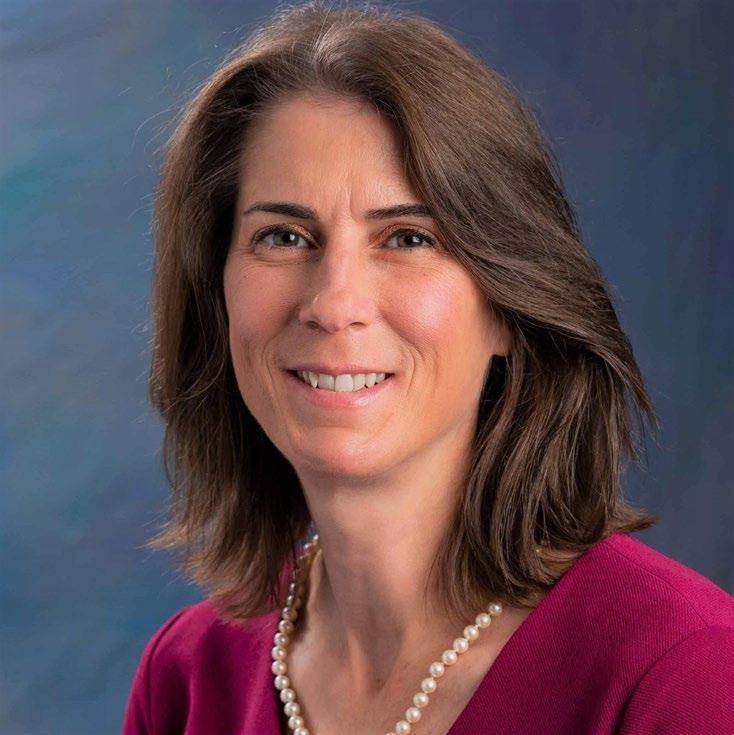

“The fact that we can deploy [BPS] on existing infrastructure is going to make it the most economical approach.”
SAM MATHENY, NAB
“The Brazilians were there in force,” she says. “We had a number of Brazilian demonstrations in the ATSC booth itself, as well. I see U.S.-based companies and/or multinational companies who are working with ATSC 3.0 solutions and services already interested in the Brazilian market. And I see people who have businesses in Brazil seeing the opportunity to potentially expand in the U.S. market.”
Several years ago, U.S. broadcasters began work on the concept of the “Broadcast Positioning System,” which uses high-powered signals from broadcast towers to accurately transmit timing to determine position, much like how GPS works with satellites.
Over time, the NAB has tested the system and in March, the FCC— in line with federal government’s desire to develop a backup/ complement to address the vulnerability of the existing satellite-based GPS—asked for public comment about the potential use of the technology as a “complement” to GPS and, in the event of actual failure, replacing GPS as a temporary solution.
“Invented and patented by NAB, BPS is a first-of-its-kind technology that leverages the ATSC 3.0 broadcast standard to transmit precise timing signals,” the NAB told the FCC. “Unlike GPS, which relies on satellites
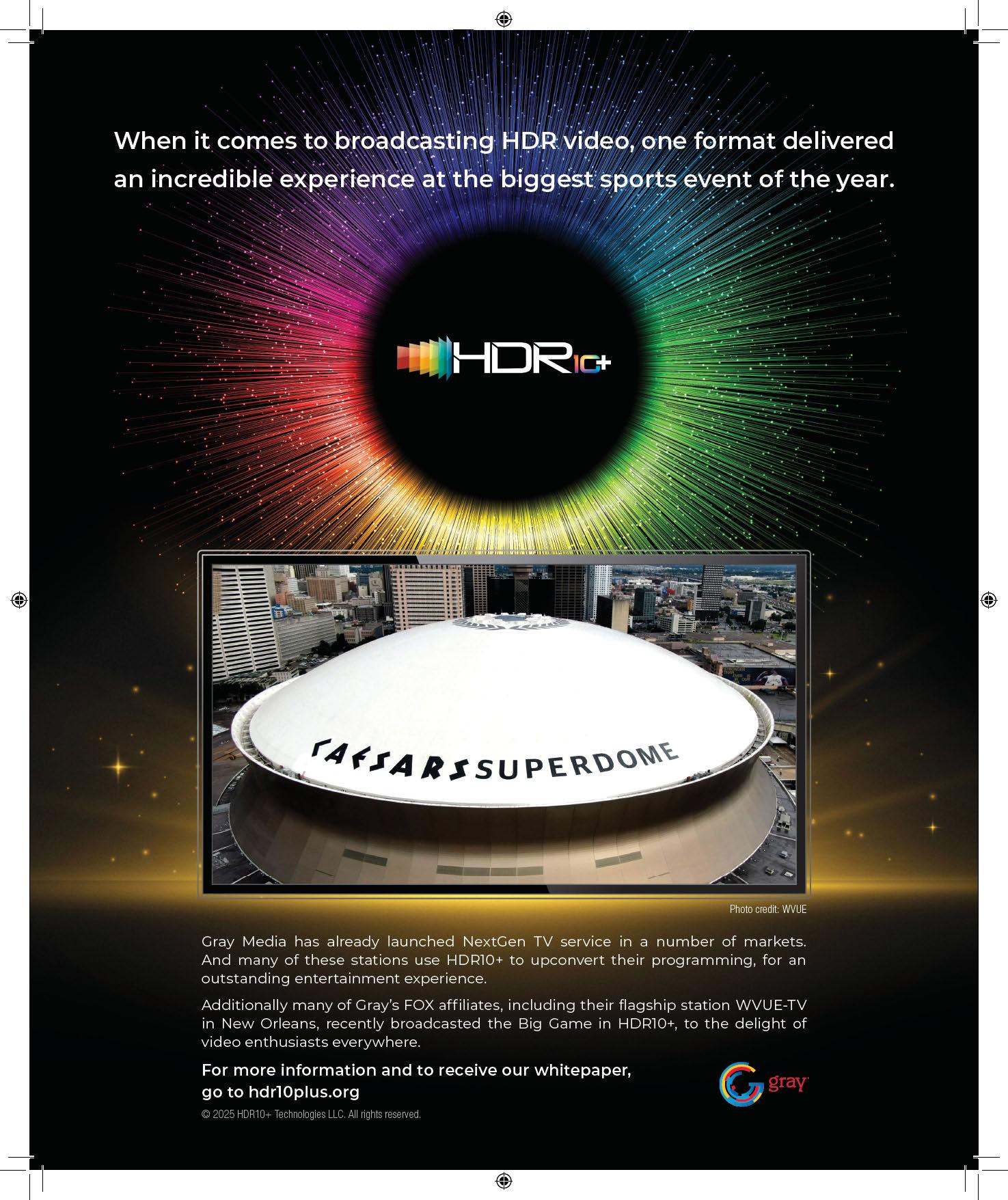
that can be vulnerable to jamming, spoofing and cyberattacks, BPS provides a high-power terrestrial-based solution that ensures critical systems remain operational even during GPS disruptions.”
At the 2025 NAB Show, the Futures Park hosted a BPS demo, using the facilities of Sinclair’s KVCW ATSC 3.0 transmission facility about 25 miles from the Las Vegas Convention Center, to demonstrate the accuracy and capabilities of BPS to attendees, including representatives from the National Institute of Standards and Technology (NIST). (For more details about the demo, see Doug Lung’s article on p. 22).
The test provided approximately 15-20 nanosecond accuracy, an impressive result, according to Harvey Arnold, senior vice president for Sinclair Broadcast Group.
“It’s incredibly good,” he said. “The standard is for less than 100 nanoseconds.”
The federal government representatives viewing the demo took note, Arnold adds. “Steve Sherman, an official with Space Force, which manages the GPS system, said, ‘This is very impressive.’ ”
Sam Metheny, chief technology officer for NAB, says the timely emergence of BPS as a viable complement to GPS could help accelerate the transition to ATSC 3.0.
“The time frame that we think is the most relevant is the time frame for ATSC 3.0’s deployment, because if you don’t have ATSC 3.0, you don’t have BPS,” he says. “And so we are suggesting that this can be very tightly aligned with deployment of ATSC 3.0, so as the investment is being made in the full transition to ATSC 3.0; you can also include BPS as part of that.”
Could BPS also be a way forward to get 3.0 tuners into mobile devices? With the Consumer Technology Association predictably opposing a tuner mandate—which it characterized as “heavy-handed and risky government intervention” in comments filed with the FCC last month—that possibility is remote for now, according to Metheny, who cited the more than 7 billion GPS receivers deployed worldwide today.
“We’d love to see that type of innovation happen on BPS, but that’s like decades-long innovation,” he said.
Metheny wouldn’t say how much it would cost to upgrade facilities for BPS, but said, “the fact that we can deploy [BPS] on existing infrastructure is going to make it the most economical approach and one that should be quite affordable. But we believe that just as the government is supplying GPS, they can supply BPS as well as a complementary solution.”
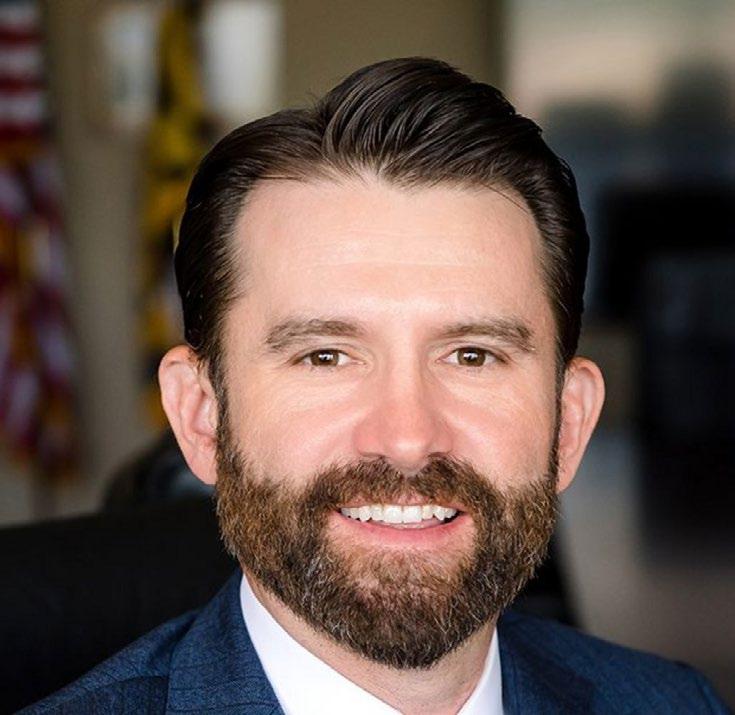
Although BPS provides an impressive and compelling technology for strengthening the nation’s GPS infrastructure, broadcasters can’t expect any revenues or compensation from it anytime soon. And since broadcasters haven’t seen any revenues from ATSC 3.0 yet, they have looked to datacasting— specifically in the enterprise space—as one of the most viable options to make money off of ATSC 3.0.
That’s why the announcement of EdgeBeam at NAB Show garnered so much attention. With four of the nation’s mostprominent station groups—Sinclair, Gray Media, Nexstar Media Group and E.W. Scripps— partnering up to launch the datacasting service, possibly by the end of this year, the industry is finally giving the technology the technical and financial backing that could make an impact. Backers of the new service see it initially deployed for software updates and data offload, with the automotive industry as among its biggest potential customers. Car makers would take advantage of broadcast’s “oneto-many” approach, which broadcasters say is more efficient than data over IP.
Sinclair President Chris Ripley believes the promise of BPS and EdgeBeam are intertwined and the success of one can help lead to the success of the other.
“I think Edge-
Beam will be incredibly helpful to getting BPS done,” he says. “We’re very involved in it, as is Nexstar and other broadcasters with NAB. And we’ve lit up BPS in Baltimore and Nexstar has done it in Denver. So I think EdgeBeam can be very helpful if we get the order from the government to roll [BPS] out, which I think we will.”
Ripley also believes that like BPS, a service such as EdgeBeam, which could see real revenues from 3.0 in the near future, can help accelerate the deployment of NextGen TV to smaller markets. With 3.0 deployed in most of the nation’s large and midsized markets, deployment to smaller markets has stalled in recent years.
Ripley says Sinclair has already received interest from other station groups and deploying EdgeBeam, the service will become more cost-effective as it matures. The key to EdgeBeam’s success is having a nationwide footprint, he says, so the more broadcasters who join the better.
“I do think as more capacity becomes available, and more stations are converted, costs can come down and EdgeBeam will potentially be the only game in town,” he says.
Ripley adds that he sees such services as “a very significant expansion of the revenue opportunities for the industry.”
“For streaming, offload, enhanced GPS and automotive, the total addressable market in those areas is like $50 billion; the total addressable market for broadcast is $40 billion,” he says. “So we’re going to be able to play in much bigger areas and diversify our revenue streams and have much more opportunity.” ●


LED displays have become an exciting and versatile component of the broadcast studio, with LED processing playing an increasingly vital role in optimising workflows and expanding the creative possibilities of what can be done with LED in these environments.
Brompton Technology, the market-leader in LED processing for the most demanding applications, has developed a range of innovative LED processing features suited for broadcast, designed to enhance image quality and broaden the creative scope when using an LED display in a filmed environment.
Among the valuable solutions these tools offer are true HDR and colour accuracy, artefact-free on-camera performance, and support for XR and multi-camera workflows – all backed by Brompton’s proven reliability and 24/7 worldwide support.
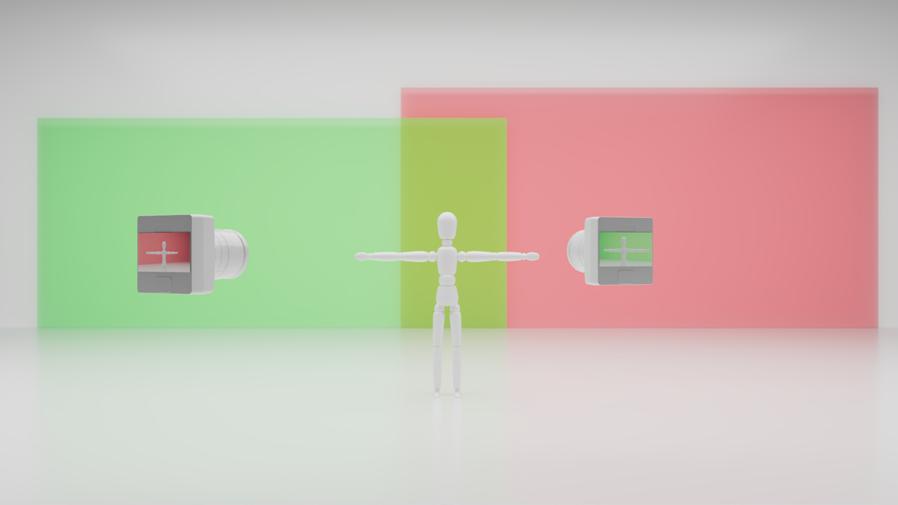
Frame Remapping is one such innovation. It enables users to have multiple, perfectly captured perspectives and simultaneously shoot green/blue screen – opening up new avenues of creative potential and production flexibility.
Cesar Caceres, Product Lead at Brompton Technology, sums it up: “It’s about expanding the possibilities of what can be done on those sets – it’s a tool you can use to easily set up more complex workflows with confidence.”
Designed for multi-camera workflows, Frame Remapping gives production teams the ability to display a unique, customised background for each camera simultaneously on the LED. In a virtual production or XR setting, this means each camera sees a unique perspective of the same 3D world, ensuring that each camera captures the correct point of view.
Frame Remapping can also display entirely different backgrounds to different cameras, or to a single high-frame-rate camera capturing two separate feeds. This is particularly useful when broadcasting the same scene to different audiences, each requiring tailored elements – such as captions in different languages or region-specific advertising.
PREPARED FOR THE UNKNOWN
Another major advantage of Frame Remapping is its ability to simultaneously capture
footage on an LED wall and a green/blue screen. The content remains identical across both, allowing the green/blue frame to serve as a mask for keying, offering a valuable fallback during post-production.
Neil Morrison, Vice President for Rental Staging at AbsenLive, praises Frame Remapping for making production “faster, more economical and more reliable”. He adds, “It’s very helpful for producers and production companies looking to do multithreaded reporting applications and preserve flexibility in post – to change out backgrounds quickly and effectively.”
Henry Ambrose, Executive Vice President/ GM of INFiLED North America, says it’s a great way to “prepare for the unknown”, explaining, “Being able to go back to post and tweak things if somebody misses their mark or something needs correcting – it’s an invaluable tool that saves content producers hours and hours, and a great deal of money.”
ADVANCED TOOLS: NOW AND THE FUTURE
Brompton Technology’s comprehensive Hidden Markers feature set further enhances the Frame Remapping workflow. With integra-
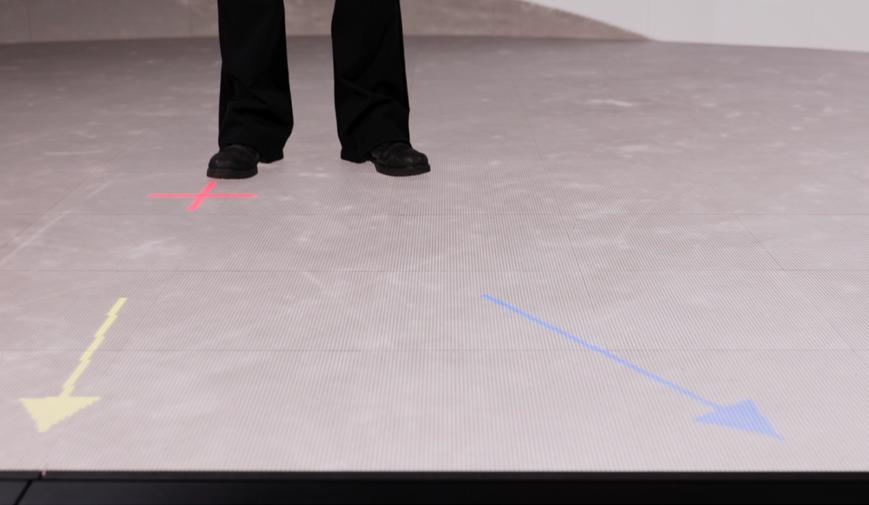
tions for Mo-Sys and stYpe, and a Custom Markers capability that allows any shape to be added as a digital marker – including visual cues for presenters – Brompton delivers unmatched flexibility for complex productions.
The next generation LED processing range from Brompton, the Tessera SQ200, continues this legacy of innovation. It addresses the growing industry demand for AV over IP while retaining Brompton’s full suite of advanced features. Like all Brompton products, the SQ200 is purpose-built for long-term ROI, with ample headroom for future development. ●
Visit the Brompton Technology website for more information on its industry-leading technologies for LED video processing in broadcast.
2025 NAB Show illustrates how the technology is ‘no longer an experiment’
By Kevin Hilton
With more broadcasters moving to cloud-based live production worldwide, this year’s NAB Show was further proof that the technology is now recognized and proven. Manufacturers and developers are progressing with new systems that run on this framework, offering broadcasters greater functionality and flexibility for producing coverage of live events.
“Cloud production remains not only current technology but also future technology in the realm of live production,” says Deon LeCointe, director of networked solutions with Sony Electronics. At NAB Show, Sony highlighted its M2 Live (M2L) multipointto-multipoint live production switcher, available as both a subscription-based version and in software form (the M2L-X).
“New features are being introduced for both of those products and we demonstrated integrations with on-prem hardware like audio consoles,” LeCointe says. “We’re also continuing to see a growing interest from a lot of our clients in what we call ‘hybrid production,’ the idea of mixing an on-prem hardware switcher with cloud-based or virtualized production resources.”
‘THIS
Costa Nikols, strategy adviser for media and entertainment at Telos Alliance, agrees that this way of working has become an established part of how broadcasting is done today. “The fact that cloud-based production is no longer an experiment was definitely one of the big takeaways this year,” he says.
Nikols says more broadcasters see cloud as a mature technology: “This year the attitude is ‘this stuff is real.’ They’re generating programs and revenue out of it.” The other significant takeaway, he adds, revolved around the Trump administration’s proposed tariffs, which, while firmly a commercial problem, seem to also be making a technological impact.
“We spent hours talking to people about this situation and the outcome was that they are seeing software, which could be licensable on an edge device, or containerized and virtu-
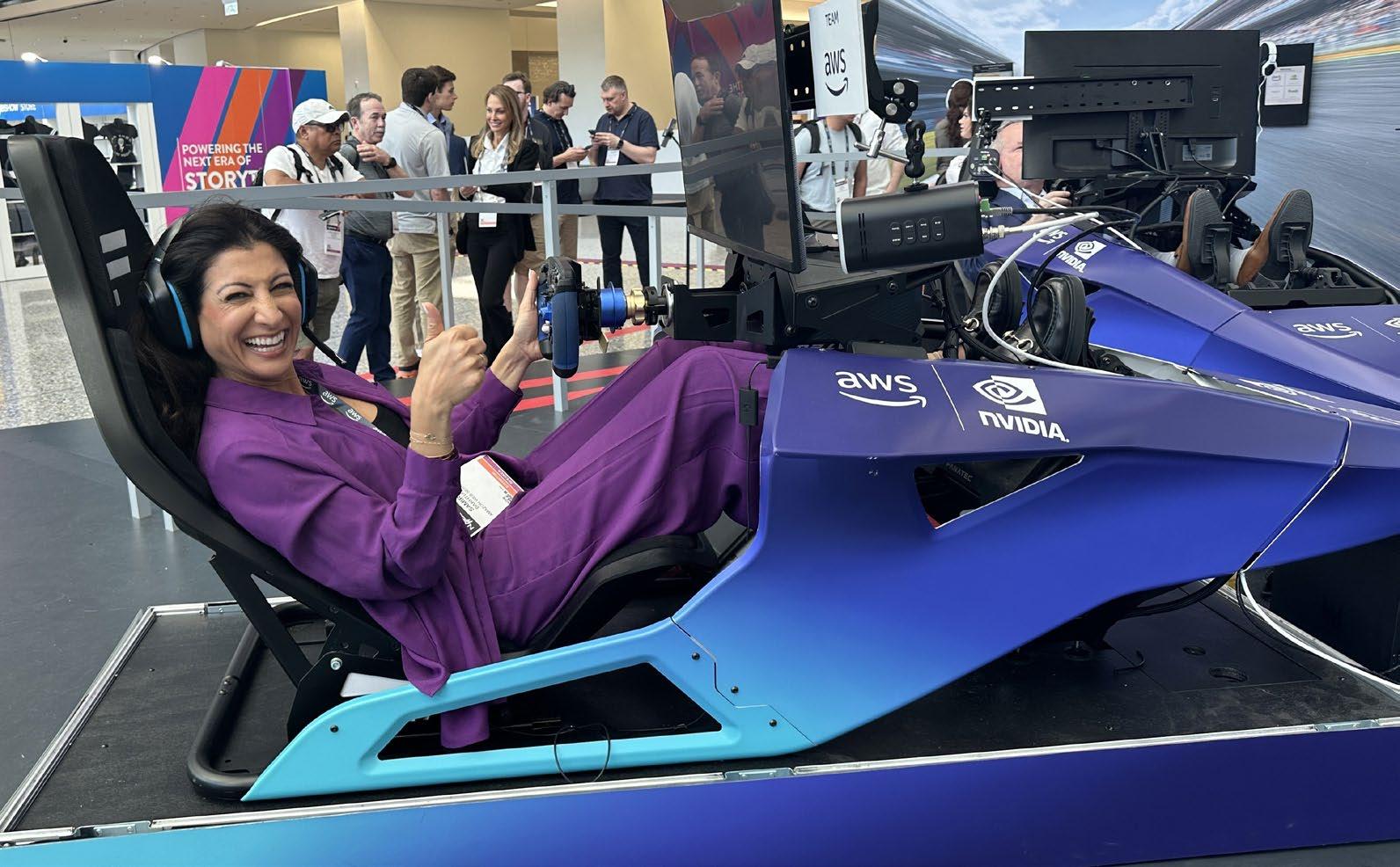
alized or running in the public cloud, as less vulnerable to tariff penalties.”
Jamie Dunn, deputy chief executive of Lawo, also acknowledges the growth in software-based systems, which, linked to the adoption of IT technologies, is bringing greater flexibility to production.
“Sometimes when people talk about the cloud, everything gets merged into one topical cloud when it’s really multiple things,” he says. “The cloud is more about agile infrastructure, which is an important topic right now and is partly driven by the move towards software and processing on standard IT technology.”
Dunn adds that the transition to IP over the past five to six years is not the significant aspect of this development but rather where it is heading. “The destination is the exciting part because it will give the flexibility to address the commercial issues,” he says. “This means having the agility to generate more content given the changes in viewing habits over the last few years.”
MORE SUBSCRIPTION FLEXIBILITY
Other companies have continued to explore this now key element of cloud
operations, with Ross Video previewing its Cloud Provisioning Service at the show.
Gary Green, vice president of cloud for Ross, explains that this is designed to quickly deploy all the infrastructure and applications necessary for an end-to-end live production.
“Cloud resources are very expensive, so if you’re not using them, you want to be able to stop them and not be paying your provider when you no longer need that service,” he says. “The Provisioning Tool lets you get the environment installed ready to be configured and up and running.”
Ross’s cloud offering has also been extended through its Rocket Surgery Virtual Productions group. This is now running Rocket Cloud Services, which, Green explains, “provides better graphics capabilities” for on-premise productions, with a major user being the Big Ten Network.
At NAB Show, TVU Networks demoed new advanced features for its cloud-based Media Hub platform, designed to transform media supply chain management. The company has taken a collaborative approach to its cloud strategy, which was demonstrated
in its work supporting France Télévisions’ broadcast of the Paris Summer Games Torch Relay last year. In recognition, the company garnered the 2025 NAB Show Project of the Year Award.
Host broadcaster France Télévisions enhanced its coverage in Paris using cloud technology, private 5G and Starlink to cut costs, reduce carbon dioxide emissions and enhance production. It was the first 100% cloud-based end-to-end 5G live production and disaster recovery plan for a tier-1 sporting event, according to the company.
The ambitious project resulted in historic outcomes: nearly 60 million views in France, a 96% drop in transmission costs, 63% savings in production expenses, and over 600 metric tons of CO2 saved.
“It’s about working together, challenging what we accept as possible,” says Paul Shen, CEO of TVU Networks, emphasizing the collaborative effort in turning visions into reality. “This isn’t just a milestone; it’s a wake-up call to the industry. The future of broadcast is here, and it’s accessible, sustainable, and opens up endless possibilities
for bringing more content to fans everywhere.”
The need for greater interconnectivity and collaboration was reflected in announcements and demonstrations by Amazon Web Services (AWS). There was a significant move forward in the Cloud Native Agile Production (CNAP) project, an open-source initiative aimed at accelerating the creation and delivery of media during live production.

transport platform and SMPTE ST 2110 support of several of its hybrid workloads.
“The industry had been asking for both of these,” Bakhtiar says. “It is also part of our investment in the Elemental Media Service portfolio.
Initial technology partners BBC R&D, Sky, CuttingRoom and Adobe were joined at the show by other broadcasters and sports production organizations, including the NHL. “We saw that really take shape and generate more momentum as we came into the NAB Show,” says Samira Bakhtiar, general manager of media and entertainment, games and sports business at AWS.
The company also announced NDI support for the AWS Elemental Media Connect video
“But the main trend we’re seeing is the rapid advancement and availability of cloud services, Generative AI and AI services being paired with purpose-built services for media, entertainment and gaming,” she adds. “The amalgamation of these things is allowing for new companies, like startups, or more established firms such as Epic, to be able to get to market faster with new products.” GenAI was demonstrated at the AWS booth to create agentic workflows to facilitate quality control, clip creation and summarization for video production.
Cloud production may not yet be universal yet but if NAB Show is any indication, it is gaining in popularity as broadcasters see its benefits both operationally and financially. ●

By James Careless
Sports fans today don’t just want to watch the game—they want to feel it. From surround sound to live player chats, the push for immersive sports audio is changing how we experience the action.
This is why “all current trends from both the creative and technological side focus on the same objective: Access and bringing fans closer to this great game,” says Jason Hedgcock, Major League Baseball’s senior director of technical production and special projects for Apple TV+.
Hedgcock’s comments are focused on baseball, but his observations apply broadly across sports broadcasting. “The use of alternative audio channels has allowed fans to access games in native languages,” he says. “Placing microphones and IFBs on players has given fans the opportunity to better see the personality of the players in the moment of action. And Dolby Atmos has offered a unique opportunity to sonically place a fan at home in the center of the action in the ballpark.
“As such, I fully expect broadcasts to continue to lean into these workflows and technology to bring fans through their screen and into the park and onto the field.”
Casual sports fans want more access to
player/athlete audio, according to Joseph Carpenter, an audio mixer for Fox Sports. “In golf, the player-caddy conversation continues to increase in demand.”
On network telecasts, announcers must be more aware of opportunities to listen in and, in some cases, are even instructed to lay out during these moments, Carpenter adds.
“TGL Golf is a new concept, with all the players wearing microphones and earpieces in order to allow the strategy and interaction to be heard at all times,” he says. “In baseball, it has become commonplace now to interview a player while he is on the field and actively playing.”

During an Apple TV+ “Friday Night Baseball” broadcast, Minnesota Twins shortstop Carlos Correa took questions from the booth while playing shortstop, “providing a look into how veteran leaders engage with their teammates on very human things like player health and how to best support a team,” Hedgcock says.
As more operations transition to SMPTE ST 2110—which allows the transport of uncompressed, high-quality media over internet protocol—the remote A1 [primary audio technician] has had to develop more expertise in IT and system networking, according to Florian Brown, ESPN senior audio supervisor.
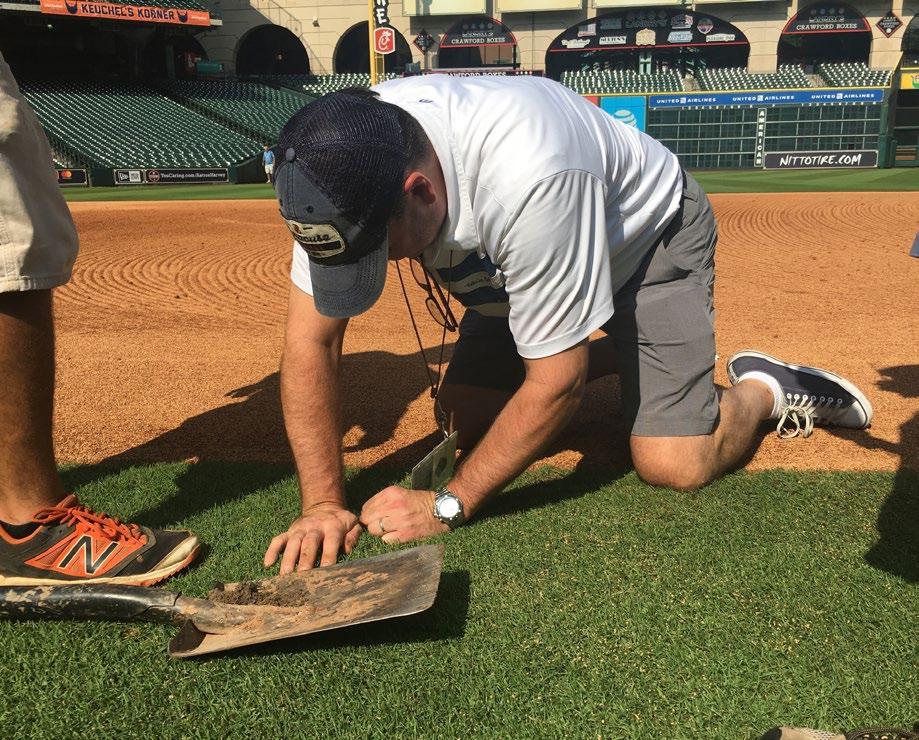
“The interconnected nature of 2110 allows for granular control over devices and even complex systems like audio consoles from remote locations,” he says. “This gives us the creative freedom to manipulate incoming sources remotely, which opens up exciting possibilities for sweetening audio and isolating specific sounds to enhance the broadcast.”
Brown isn’t alone in viewing 2110 as a game-changer. Carpenter, a 35-year veteran, says he has seen a number of transitions, but “the current wave of audio-over-IP solutions
is certainly one of the more impactful shifts I’ve witnessed. High-quality audio being seamlessly transported and decoded across varying platforms and hosts has become commonplace with the latest coalescence of 2110 and real-time protocols.”
Brown concurs. “As we reach the full potential of 2110 connectivity, we continue to push into a more immersive experience for the consumer,” he says. “The demand for richer audio certainly goes hand-in-hand with higher-quality video.”
Giving broadcasters the ability to support multilingual audio commentary using 2110 helps Apple TV+, ESPN, Fox Sports and other media outlets attract viewers in an increasingly fragmented media market. But these two trends have to be deployed in tandem to deliver the desired result.
“In a diversifying media landscape, simply putting the game on isn’t enough to attract and engage an audience,” Hedgcock says. “You need to be creative in the storytelling. [Now] the human aspect of the game is one of the hardest things to capture, so the intimacy that audio can provide is a powerful tool broadcasters can use to drive humanity home. Rather than a simple natural sound mix to hear the roar of the crowd, a 5.1 or 7.2 mix can be used to place a fan among their peers in the park.”
As captivating as today’s multichannel immersive sports audio is, more progress may
yet be needed to deliver its full impact to viewers.
“Much like the brief attempt to broadcast video in 3D required wearing glasses, I feel as though the current trend to deliver immersive sound to viewers at home will require a quantum leap in affordable home theater equipment,” Carpenter says. “That being said, the quality of audio being delivered to portable devices like smartphones and tablets is hitting its stride.”
As for the future of sports audio?
“A fully matured 2110 environment for broadcasters and end users will allow us to isolate even more detail and emotion from a sporting event,” Brown says.
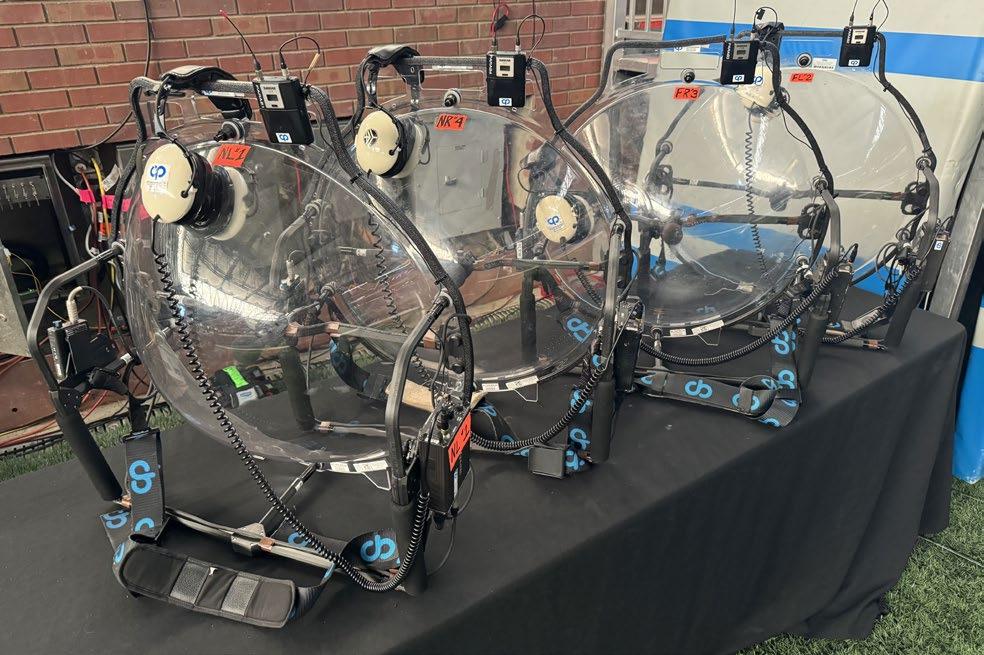
“This will give us the ability to define the user experience at the source and deliver that to the customer as intended, without third-party manipulation. That is the ultimate goal, and we are well on our way.”
As fans continue to migrate to mobile devices and use headphones to listen to broadcasts, some of the next generation of innovation will focus on “getting the big sounds out of little speakers,” according to Hedgcock.
“Similar to how musical mixers leaned into mixes for radio for years, I expect sports mixers to listen to their shows on various headphone options, both over-the-ear and in-ear, to fine-tune their mixes,” he says.
“I also think we will see even greater use of on-field player microphones, plus the reemergence of the all-audio games that MLB Network tested back in 2012. These games— where the broadcast team largely laid out,
letting the sounds of the ballpark and players dominate the audio track— would offer an incredibly unique experience and can be made available as a complement to the traditional broadcast.”
Carpenter is very optimistic about sports audio’s future progress and impact.
“I believe now that video quality has reached such incredible heights, and super slow motion has become ubiquitous in instant replay for referee and umpire calls in all sports, that audio is becoming the next frontier in captivating viewers’ attention and bringing to light the true level of athleticism and passion we have begun to take for granted as technology advances,” he says. “In the meantime, I will continue to try to innovate new ways to push the sonic envelope and ‘bring it to the people’ at home.”
Again, all of these sports audio innovations share a common goal: Shrinking the distance between athlete and audience. In a world of fragmented attention and media overload, sound may be the clearest path to the hearts—and loyalty—of today’s viewers. ●

Over the years, there has been one thing I have consistently written about: change. How are things evolving, and what can we do to get ready for these changes? In this column, I want to share my thoughts on the future, based on four decades of experience in guiding clients through uncertain times. Recently, many of us attended the NAB Show, which reminded us that the future in the media industry is always uncertain.

training and daily upkeep. Editing required a room that cost $20,000 to $30,000 for basic cuts and up to a $1 million suite (in 1985 dollars) for full effects. Back in 1985, distribution channels were limited. Without network backing, you would have had to go through public access TV or distribute VHS tapes yourself, which made getting your content out there tough.
Change is unpredictable. If you look at the NAB Show agenda from 10 or 15 years ago, you will notice that some big topics back then, like 3D television, did not have the impact we thought they would. On the flip side, today’s hot topics, like artificial intelligence, barely got a mention back then.
No one can predict the future perfectly. To get ready for different possibilities, it is crucial to have a flexible business model, a talented team, and adaptable technology. These factors are all connected; a change in one affects the others. During my career, I have seen a lot of unexpected changes.
Oddly, innovative ideas would pop up quickly and shift our thinking but fully implementing them often took much longer than expected. For instance, moving from tape to file-based workflows took decades after it started.
Think about how things have changed over the last 40 years:
When I first got into the industry, tape formats were the critical topic. Betacam had come onto the scene, but everyone was wondering if they should wait for Betacam SP or M2. We had computers, but they were just for text and not part of our workflow. Tube cameras were the norm, and edit rooms looked like space launch control centers. Cable TV was growing like crazy.
A camera operator needed a big, shouldermounted camera with a battery belt and a tape deck. Using the camera meant serious
We were now getting into file-based systems. Computers could make videos! We developed nonlinear editing and many other computer-based technologies and began to slowly—very slowly—get rid of tape in our facilities. We had solid-state cameras. Cable had exploded and the internet was just entering our consciousness.
The digital revolution was underway in

more than one sense of that word. Digital TV! Internet-based video services. Standardized HDTV was here, and in the U.S. we were trying to figure out how to deal with the move from 4:3 to 16:9 aspect ratios. Phones did more than make calls and were everywhere. They had screens that were playing video. user-generated content (UGC) was arising in online services. Cat videos were everywhere.
By 2005, that cameraperson had an integrated camcorder that was solid state with no need for separate battery and VTR. Consumer camcorders were in the market for under $1,500 with superior performance to the images of 1985 and it was a more stable and easier-to-use device. We now could edit on a computer and an edit suite was $5,000 with full mix and effects capabilities.
Think about what a difference that is—in 20 years, we made professional-quality media production capabilities available to anyone who could pull together single digit thousands of dollars, down from nearly $1 million. Many more people could make content, and they were.
You had many more options for distribution. There were hundreds or even thousands of TV channels and you also had internet-based distribution options including early social media and streaming services. You had a greater chance of being seen by audiences.
Change continues; now we are talking 4K, even early 8K! Streaming is all the rage and we are now immersed in augmented reality (AR) and virtual reality (VR). ATSC 3.0 was on the drawing board. Targeted ads were driving new revenue and the competitive landscape was changing with new media entrants.
Any number of trends are critical today. Of course, there is AI, as has been discussed extensively in this column. But not just that— our business is being severely disrupted by streaming wars and the rise of social media, especially by Generation Z. We have mobile devices that can shoot professional quality videos and even edit them.
Today, all the capability you need to make professional content is in your pocket for under $1,000. You can shoot and edit high-quality content with professional-grade mix and effects with the device you carry around with you everyday: From around $2 million in today’s dollars to less than $1,000 in 40 years.
You also have a tremendous number of options to get your content out; self-publishing is available to anyone on video-sharing sites and
social media and the audience is now there. You can go “viral” if you have the right content and monetize without the same level of difficulty you would encounter just 20 years before.
Can you predict what 2035 will look like? I cannot. But there are some clear trends here we should recognize to help us look forward. There is a megatrend in the above: From 1985 to 2025, content production and distribution were democratized dramatically, from the few people who could make and distribute professional content to almost everyone. I have every reason to believe that these democratization trends will continue. We have evidence that they will already. When it comes
ing in transformation efforts from getting off tape to turning on AI.
What is most important here is to focus on business. All the technology and operational decisions are downstream of what the business is trying to accomplish. Of course, engineers are creative, too, and should become even more embedded in business to provide innovative ideas.
From a technological perspective, there are a couple of key things that will always be good to engage in—not only for your needs today, but to be ready for the future. You need to have a highly flexible infrastructure on which the business runs and a systems architecture that is flexible and easy to change. What does that mean in the modern era?
to look at how to create services that can be reorchestrated or changed without breaking everything else. The term “Service Oriented Architecture” is not dead and applies today just as much as it used to. It’s worth getting familiar with, as AI does not deprecate SOA. And then there is our data layer, which often lacks a unified source of truth or consistent dwata. We need to continue to engage in the endless project of making our data layer better through master data management, governance, metadata cleansing and even metadata generation. We need to do everything we can to have a clean pool of data our systems can rely on. AI only really works with good data to train and execute with.

I hope all this gives you comfort that you will not be out of work soon. It has been an incredible 40 years. I believe that in the next 40 years, we will have at least as much change to work through and enjoy. We all have much to do between now and 2035. Let’s get to it! ●
John Footen is a managing director who leads Deloitte Consulting LLP’s media technology and operations practice. He can be reached













Proper planning is key to avoiding effects of ‘cloud stall’
Many organizations use the cloud to augment traditional data center capabilities. Such complementary uses often include storage, data processing and records management, such as HR or taxes.
According to World Wide Technology, 90% of business organizations will leverage the cloud at some level. Half or more of businesses surveyed said they are shifting IT budgets to cloud, and nearly two-thirds are already at some level of cloud deployment.

add capabilities until the model develops into a mature, functional solution that meets the needs of the business and its activities.
A cloud solution is not an overnight activity; it can and often will require many iterative processes or stages. Technologies available today may become inefficient or even obsolete during workflow development and utilization.
Given the broad reach and capabilities of the varying technology stacks, it can be challenging to properly and efficiently harness the cloud’s potential. Many who “go at it on their own” find themselves making mistakes such as:
data stored in the cloud is inherently secure. The team, therefore, doesn’t implement robust backup procedures. Actions, including accidental deletions, cyberattacks or system failures, could expose the absence of a backup plan, which could result in irretrievable data loss.
4. Insufficient Employee Training: Lack of sufficient and proper training is a common cloud deployment mistake that cloud startup managers often overlook. Administrators and managers might assume a team can rapidly adapt to new cloud tools and services without comprehensive training. Such misconceptions often lead to a significant gap in skillsets in various segments of the business units and staff.
5. Not Understanding Cloud Costs: This is a common mistake and will eventually result in a costly impact. Teams often don’t recognize costs and may overlook the nuances of cloud pricing models, underestimating the financial implications of their deployments. This can result in a cycle of reactive cost optimization, i.e., scrambling to rein in expenses after they’ve spiraled out of control.
All these efforts mean workflows are rapidly changing, despite the fact that cloud migration can be complicated. When shifting to the cloud or an adoption initiative slows down (or, in some cases, grinds to a halt), this is referred to as “cloud stall,” which can be debilitating and embarrassing across the board. Therefore, adopting a “cloud strategy” is essential to mitigating the potential impact of cloud stall. Missing the planning portion of cloud implementation often results in misconfigurations and usually leads to suboptimal cloud deployments. Eventually, the organization will find itself needing to backtrack and correct various errors—sometimes with lengthy downtimes or costly reworks.
The modern digital transformation, for business or private purposes, has almost completely shifted to the cloud. Successfully reaching this transformation—whether you’re new to cloud or you’ve already invested in a public, private or hybrid deployment model—could very well depend on your ability to systematically reach and mature your cloud capabilities.
A “cloud maturity model” (CMM) is a framework that helps organizations assess their current cloud capabilities and identify areas for improvement as they adopt and utilize cloud services. This model (Fig. 1) outlines distinct stages of progress, each with increasing levels of cloud usage and optimization; you start out small and
1. Lack of Adequate Cloud Security: As the organization rushes to migrate its applications to the cloud, it may find the oversight of robust security measures ends up exposing sensitive data to potential threats, including data breaches, unauthorized access or even service disruptions.
2. No Proper Strategy for Monitoring and Maintenance: Failing to establish proper protocols, including monitoring tools and maintenance procedures, can result in performance bottlenecks, outages and a compromised user experience.
3. Inadequate Backup and Disaster Recovery Plans: Envision an engineer who assumes that
6. Rushing Cloud Migration: The excitement around the “cloud promise,” such as improved scalability or flexible agility, could lead teams to not thoroughly assess their readiness for the cloud environment and, in turn, hastily migrate applications with improper parameters or useless end results.
By rushing into cloud migrations, poor results with cost overruns may occur. To mitigate this possibility, engineers and startup founders should prioritize cloud implementation processes using a comprehensive planning procedure, sometimes provided by a third party skilled in the steps and stages of cloud implementation for your business type.
7. Improper Resource Allocation: A common stumbling block for engineers, administrators and startup founders is not providing adequate

resources (people, materials, testing, etc.). This could also include the overprovisioning of server resources in anticipation of much higher demand than materializes in reality. These startup errors could risk losing customers and damaging your reputation as users experience a subpar application performance.
“On average cloud deployments don’t go well,” as was quoted in a CIO article in 2015. Back in those days, “70% of the implementations required changes,” “43% of the cloud projects failed or stalled” and “close to half required an increase in budget within six months,” according to THINKstrategies and INetU surveys on enterprise migration to the cloud.
Things have changed dramatically in the past decade and success rates are much higher now. Nonetheless, mitigating common cloud deployment mishaps is essential for ensuring the success, security and efficiency of any cloud-based implementation. Fig. 2 shows some examples for consideration that might make sense when looking to move your organization to the cloud or “re-architecting” an existing platform into a more mature solution set.

Whatever your situation, look thoroughly and plan appropriately for both the immediate and long-term activities your organization must address and seek advice accordingly to alleviate risk and failures. ●
Karl Paulsen is a retired CTO and a frequent contributor to TV Tech on topics of workflow, system design, AI and cloud computing for the media and entertainment industries. You can reach him at TV Tech or karl@ivideoserver.tv




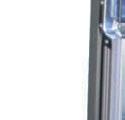
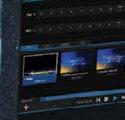

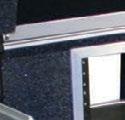
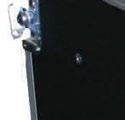
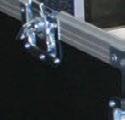

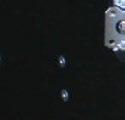
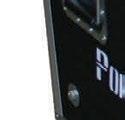
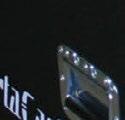



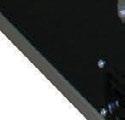




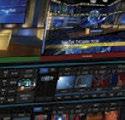
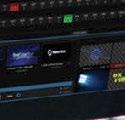
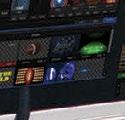
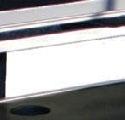
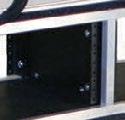




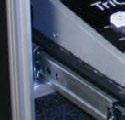

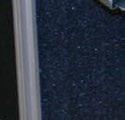
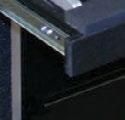

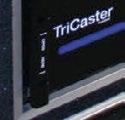



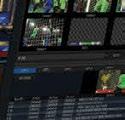

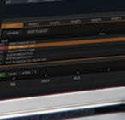

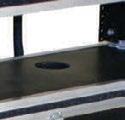
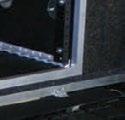
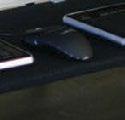
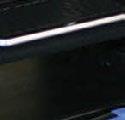







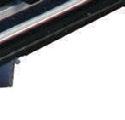




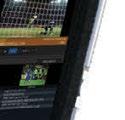


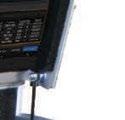





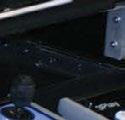


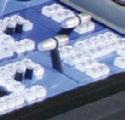
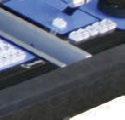
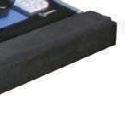

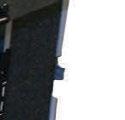

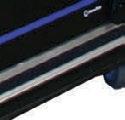







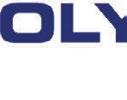



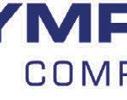
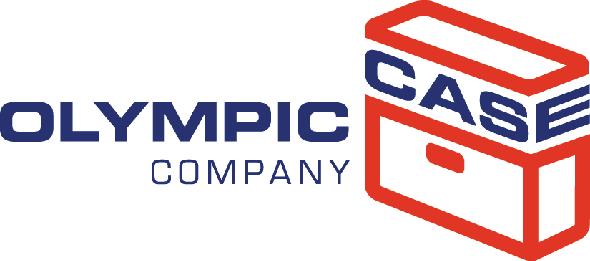


NAB’s February petition to the FCC to shut off ATSC 1.0 in the top 55 markets less than three years from now focused increased attention on ATSC 3.0 at the 2025 NAB Show. I found no lack of products for broadcasters looking to switch to ATSC 3.0 and, as others and I have shown in articles on previous NAB Shows, there are now several low-cost options for encoding and transmitting ATSC 3.0 signals.
However, until enough viewers have ATSC 3.0-compatible TVs and the commission relaxes rules requiring stations to continue broadcasting on ATSC 1.0 shared channels, any ATSC 1.0 shutdown will be difficult. What broadcasters have been looking for since starting ATSC 3.0 broadcasts is a “killer app” that will drive the transition to NextGen TV.
At NAB Show, I got the impression that “killer app” is the Broad-
cast Positioning System. It provides precise timing—and with a sufficient number of stations— accurate positioning. The FCC’s notice of inquiry on “Promoting the Development of Positioning, Navigation, and Timing [PNT] Technologies and Solutions” (WT-Docket 25-110) outlines the need for an alternative PNT system.
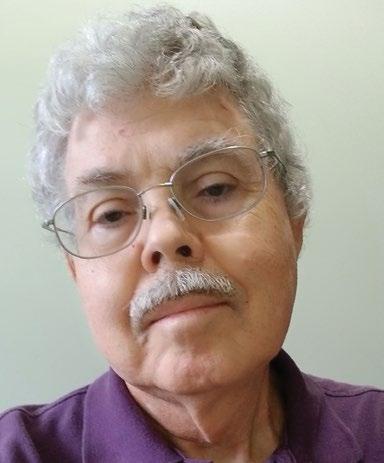
on nationwide ATSC 3.0 coverage. If the government wants BPS, broadcasters hope it will encourage the government to provide regulatory and perhaps financial support for the ATSC 3.0 transition needed for BPS.
Is BPS a good enough alternative?
nanoseconds of the UTC (NIST) standard time, except for a sudden time shift of approximately -25 nanoseconds, which the presentation said “is likely related to known operator maintenance activity that involved lower transmitter power and/ or a possible change to undetermined interference in the NLOS [non-line-of-sight] propagation of KWGN to NIST Boulder.”
The paper, available in the NAB 2025 BEIT Conference Proceedings, includes details on testing and comparisons to GPS accuracy, with the results of the tests showing BPS comparable to GPS L1 band. Additional information is available in the paper “Time Transfer Performance of the Broadcast Positioning System.”
BPS is an alternative PNT system using ATSC 3.0 stations. One advantage of BPS is that it is very resistant to jamming or spoofing (substituting valid data with inaccurate data) due to the high power, large number and wide frequency range of TV transmitters (VHF and UHF). A nationwide BPS depends
In Denver, the National Institute of Standards and Technology (NIST), TV station KWGN and the NAB worked together to test BPS reliability and accuracy. The results were presented in “Field Test of ATSC 3.0/BPS Precise Time Distribution” at the Broadcast Engineering and IT Conference at the NAB Show by Jeff Sherman, supervisory physicist at NIST.
The test found that BPS time was within plus or minus 10
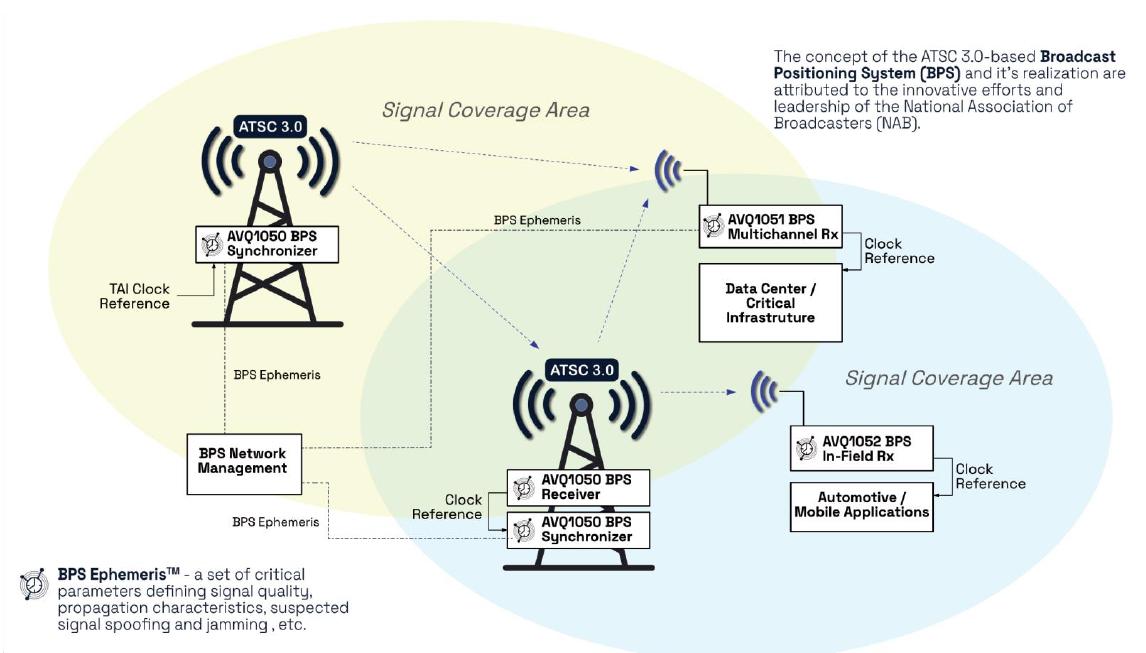
How difficult is it to deploy BPS? For a BPS station to provide accurate time, it requires its own traceable time standard. These are expensive, but two alternatives were covered at the show.
One option uses a station with a traceable time standard as a “leader” other stations, or “followers,” can use as a reference. A test setup, using stations WHUT in Washington, D.C., (the “leader”) and WNUV Baltimore (the “follower”), showed how this works. Details on the system and its configuration were provided in “BPS Mesh Network Initial Deployment Report,” a BEIT presentation by Mark Corl, senior vice president, emergent technology, Triveni Digital.
The other time reference, demonstrated in an NAB PILOT exhibit with Sinclair’s ATSC 3.0 station KVCW, used an eLORAN station as the reference. The NAB’s comments in FCC WT Docket No. 25-110 pointed out that BPS could be part of a “system of systems.”
The eLORAN demonstration is an example of one system providing a reference for BPS; BPS could also provide a reference for other timing systems, such as the networking Precision Time Protocol (PTP). For BPS to be a reliable backup for GPS, many more stations will
Average signal reception:

BPS coverage at full deployment.
have to transmit it. Monitoring will be required to ensure BPS stations are transmitting accurate time. A station transmitting BPS data will need to add a robust PLP (QPSK with 2/15 coding) to carry the broadcast time information. Less than 10 kbps is required, so the impact on total channel capacity is minimal. Additional equipment is required to add the time data and adjust the timing of the transmitted signal. Avateq outlined a basic BPS configuration at Rohde & Schwarz’s tech talk at NAB Show. “BPS Network Application Diagram” from this presentation shows the components in a leaderfollower BPS configuration. At this time, Avateq and Triveni are the only suppliers of BPS-compatible equipment, and only two transmitter companies—GatesAir and Rohde & Schwarz—have exciters that work with BPS. I talked with other gateway and transmitter vendors at NAB Show and got the impression that if a market develops for BPS products, they will support it. During the session Q&A, the cost to add BPS to a station was quoted as “about $200,000.” That wasn’t broken down, but I expect
• 17 towers at 1.5 m antenna height
• 70 towers at 50 m antenna height
Receivers will have to identify individual transmitters on the same channel, whether transmitters in an SFN or other co-channel stations. With a BPS PLP signal-to-noise ratio of -5 dB, there will be locations where two or more stations’ coverage overlaps, so this will be important. When multiple transmitters are received on the same channel, Avateq’s receiver uses the signal that arrives first for the time reference.
Coverage at 1.5m antenna height:
At demodulation threshold (-5 dB SINR)
Threshold +10 dB
Threshold +20 dB
the traceable time reference or stable holdover reference is a large part of this.
Will BPS work with a single frequency network of transmitters (SFN) or with translators? BPS depends not only on precise time transmission, but transmission of the precise location of the BPS station. That’s necessary to account for how long it takes the time transmitted from the station to reach the BPS receiver. A 6-meter error in distance will result in an error of approximately 20 nanoseconds.
Obviously, timing could be a problem if the original BPS station’s time is transmitted on multiple stations in an SFN or via translators. The good news is the ATSC 3.0 standard allows for each transmitter in an SFN to have its
own identifier that specifies its location. Each translator or transmitter with BPS in an SFN will require a traceable reference time source. SFNs today rely on GPS for synchronizing transmission frequency and time, but if BPS is to be a backup for GPS, another reference will be needed. Since the BPS data will be transmitted in a very robust PLP, signals from other BPS stations should be available as a reference.
The added complexity for SFNs and translators needs to be considered when calculating the cost to broadcasters for implementing BPS. While having BPS on translators would provide coverage in remote areas, in the end it may be simpler to strip BPS data from the translator’s signal, especially if robust streams from distant full-power stations are receivable in those areas.
Engineers have done a great job developing the technology that enables BPS. Let’s hope the government and business lets us take advantage of it.
I’m sure any remaining technical issues will be resolved and, if there is government and broadcaster support for BPS, equipment will be available from multiple vendors.
We’re seeing increasing interest in data transmission as a potential revenue source (a “broadcast CDN”). Where does BPS fit in? Can broadcasters charge BPS users for the service? During one of the NAB sessions on BPS, it was estimated that loss of GPS for a period of 90 days would result in costs of over $1 billion per day. Will power companies, financial institutions and other critical users that depend on a precision time reference, including the government, be willing to pay broadcasters to transmit BPS as insurance against GPS loss? Can we count on individual broadcasters to successfully deploy BPS? Larger station groups have the resources to do this, but some sort of a prepackaged solution that can be installed, maintained and remotely monitored at smaller stations will be necessary. Engineers have done a great job developing the technology that enables BPS. Let’s hope the government and business lets us take advantage of it.
In my next column, I’ll cover other topics from the 2025 NAB Show as well as some testing I did with a $59 (as this was written) USB ATSC 3.0 receiver that can plug into an Android phone while in Las Vegas. As always, your comments are welcome!
Please share your comments at dlung@transmitter.com.
Carbonite HyperMax
is a new flexible and powerful platform for production switching, routing, video and audio processing, multiviewer monitoring and ultra-high-resolution video compositing. It allows organizations to configure their tools to suit every production, integrating all of Ross Video’s production technology into a single, powerful hyperconverged platform.

CloudCap is a new cloudrelay service that establishes a secure connection to on-prem captioning workflows for third-party remote stenographers and captioning services working in live broadcast environments. ENCO’s new CloudCap Delivery Network builds a bridge to ENCO DoCaption closed-caption encoders, giving third-party captioners a direct and secure line into the broadcaster’s workflow.
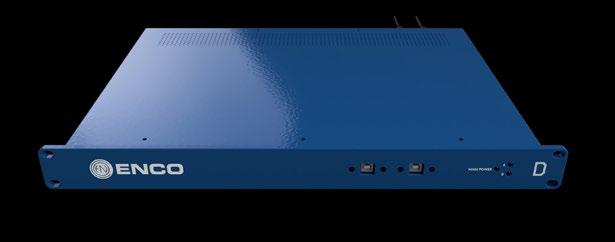
Features include a software-defined production engine with one license for multiple functions; Ross Platform Manager, an enterprise-level control system for managing software licenses and configurations across SDPE blades and stand-alone Ross switchers; full compatibility with the TouchDrive family of control surfaces; and a compact, powerefficient home for SPDE blades in Ultrix FR5 and FR12 frames.
❚ www.rossvideo.com
IMPULSE consolidates functions provided by For-A products into one host machine. IMPULSE (Integrated Media Platform with UnLimited StructurE) features signal processing, multiviewer, switching, graphics, audio mixing and a media player as software function nodes.
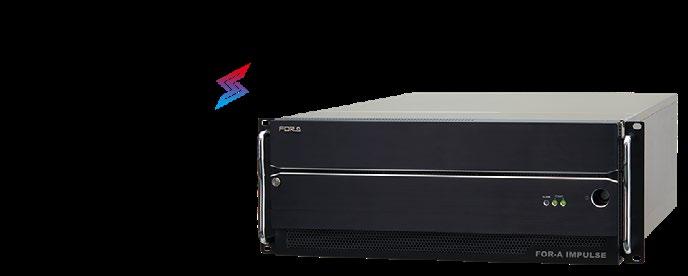
Operators can connect nodes by using the platform’s graph editor to create production pipelines. Because it’s a software-based solution, it’s easy to reconfigure the pipelines depending on the specific application. The IMPULSE platform can be deployed seamlessly on-premises, in data centers or within public cloud environments. For cloud deployments, planned for future delivery, FOR-A IMPULSE will enable a cost-effective approach, starting with lightweight instances for simple production pipelines. Users will then be able to scale instance sizes on-demand, optimizing expenses as needed.
❚ www.for-a.com
Nugen Audio has launched DialogCheck, a new speech intelligibility plug-in that offers a mono, stereo and multichannel dialog clarity meter and provides an objective measure of speech audio intelligibility. DialogCheck is ideally suited for use in film, TV, radio, podcasting and game audio production, as well as postproduction environments.
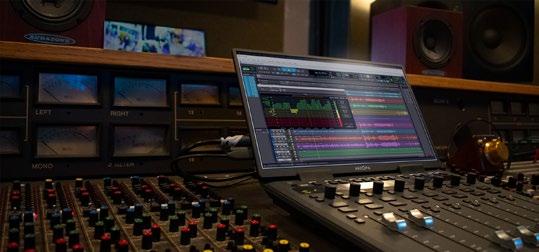
DialogCheck features more than a dozen interface tools to support engineers in their dialogue editing process, such as an integrated real-time bar meter and history graph. Additionally, the distribution view and numerical statistical values provide an overview of the entire program’s speech intelligibility. This information can then be used to guide engineers to correct issues before testing again. Furthermore, the tracking function syncs the views with the audio playback in the DAW, while “Macro View” highlights the current audio section within the wider historical view.
❚ nugenaudio.com
CloudCap’s debut coincides with the availability of ENCO’s DoCaption EN848 closed-captioning encoder, which provides reliable, automated conversion and delivery of captions and translations produced in-house or via external services. The EN848’s availability provides broadcasters with the opportunity to deploy the system over the IP network, with connectivity to cloud-based captioning services such as those offered by ENCO’s partner, Verbit. The EN848’s core function is to reliably and securely insert closed captions from any source in compliance with global captioning standards.
❚ www.enco.com
Harmonic has added new features to its playout-to-delivery solutions: VOS360 Media SaaS for cloud deployments, as well as VOS Media Software and XOS Advanced Media Processor for on-premises deployments. The features can be controlled via API and managed by thirdparty automation systems. Whether recording live streams, scheduling branded playout or originating linear channels for distribution, Harmonic says it now offers a “unified playout-to-delivery workflow.”

At the core of the updates are loop record and delay line features. Loop record enables broadcasters and content owners to simultaneously record and replay live streams. They can also edit recorded assets via a built-in clip editor for quick trimming of video content for rapid replay. The addition of delay line features allows stream playback with an adjustable delay, supporting applications like time-zone shifting.
❚ www.harmonicinc.com
Triveni Digital and Brazilian technology provider Mirakulo have developed a dynamic ad-insertion delivery system for over-the-air platforms ATSC 3.0 and Brazil’s TV 3.0 (DTV+). The system enables selection and playback of ads on TV receivers based on criteria such as a viewer’s location or habits, marking a significant advance in broadcast advertising technology.
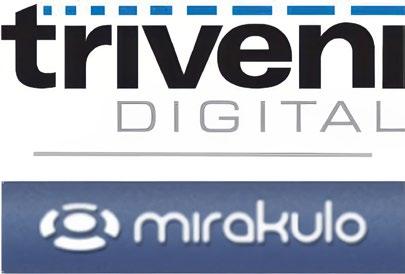
The new dynamic ad-insertion delivery system provides broadcasters with a capability previously limited to streaming platforms. The end-to-end solution enables broadcasters to reach viewers with highly targeted and personalized ads over the air for selection and presentation in the receiver, the companies said. Compatible with both the ATSC 3.0 and TV 3.0 standards, the system integrates seamlessly with Triveni Digital’s broadcast-chain products, including GuideBuilder XM and ATSC 3.0 Broadcast Gateway.
❚ www.trivenidigital.com
❚ www.mirakulo.com
PrimeTime Lighting
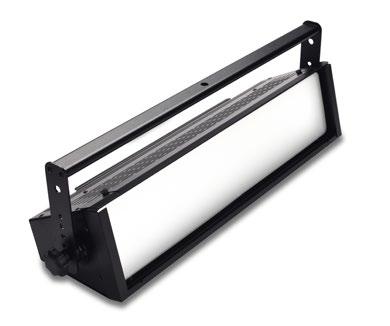
Systems now offers studio lights in variable white temperatures. The VariWhite series LED luminaires feature variable white or bicolor temperatures tunable from 3,200 Kelvin to 5,600 K with a smooth transition to zero. PrimeTime makes lights for broadcast production, news stations, streaming video studios and for content creators.
Designed for pro broadcast studio grids for key light, fill, side or backlight talent on chroma key or interview sets. PrimeTime’s VariWhite includes RDM protocol for brightness and Kelvin temperature; it is equipped with DMX512 and a digital display interface. “PrimeTime’s VariWhite makes talent look fantastic, with a smooth and soft quality light, Lambertian distribution, long-throw and a soft shadow wraparound that outperforms panel lights,” CEO Glen Harn said. “Our lights are used in television broadcast studios, sports and university news sets, broadcast worship services, distance learning and streaming video facilities.”
❚ primetimelighting.com
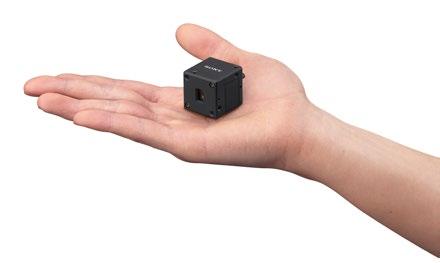
Sony Electronics has commercialized its AS-DT1 LiDAR depth sensor, a 1.14-inch wide by 1.14-inch high by 1.22-inch deep unit, excluding protrusions, that leverages miniaturization and optical lens technologies from Sony’s machine vision industrial cameras for applications where space and weight constraints are paramount.
The 1.76-ounce LiDAR depth sensor uses Direct Time of Flight (dToF) LiDAR technology, which delivers fast and accurate measurement, distance resolution and measuring range. The proprietary dToF ranging module, equipped with a Single Photon Avalanche Diode (SPAD) sensor, uses multiple ranging points for distance measurement and can accurately measure distances in three dimensions: length, width and depth, the company said. The sensor’s compact, lightweight design and rigid aluminum housing allow for integration into a wide range of devices, including drones. The AS-DT1 is expected to be available in spring 2026.
❚ pro.sony/ue_US
ARRI’s Camera Companion App for iPhone, iPad and Mac with Apple Silicon enables users to configure a personalized interface for remote control of one or multiple ALEXA 35, ALEXA Mini LF, ALEXA Mini, AMIRA, and ALEXA 265 cameras. With a choice of two subscription options, Camera Companion’s flexible interface streamlines on-set workflows for camera crews and DITs. The Standard subscription provides comprehensive control of one or two ARRI cameras, while the Premium subscription adds features such as unlimited cameras and MIDI support, the company said. With a Premium subscription, the interface can be organized into multiple tabs, so users can create separate tabs for different cameras or shooting situations. ARRI’s Camera Companion is now available on the Apple App Store. ❚ www.arri.com/en
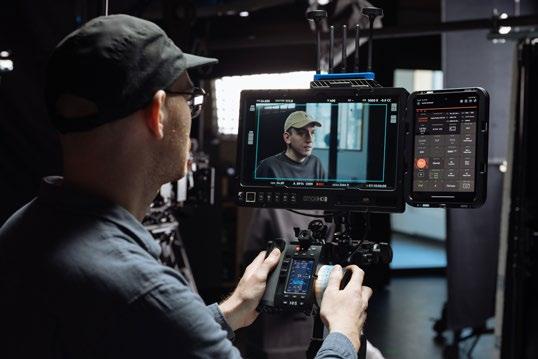
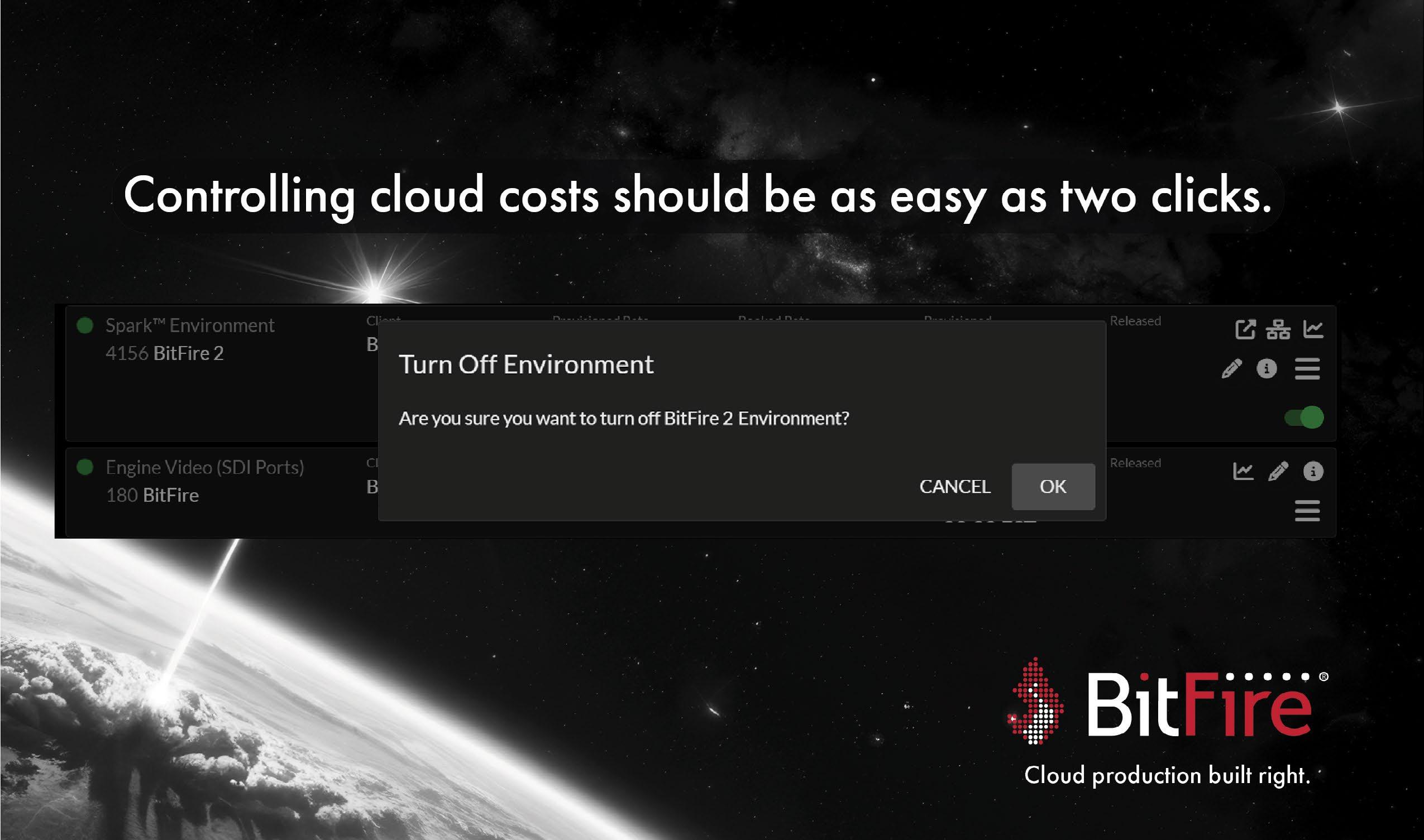

AP Newsroom is a new multiformat AI-powered content delivery platform that offers a redesigned interface and a wide range of new and enhanced features, including AI-powered search and content recommendations, as well as intuitive navigation and customizable homepages to make the user experience faster and easier.
New features include “Storylines,” a tool powered by Storytelling AI from ShortTok that makes it easy to discover curated video and photo content organized around key themes and stories; “More Like This,” also from ShortTok, which leverages AI to display visually similar and contextually relevant related content; customizable homepages that allow users to focus on the topics, regions and formats that matter most to them; access to content in AP’s exclusive historical archives; and breaking news alerts, now with audio alerting. ❚ www.ap.org/solutions/platforms/ newsroom-platform/
The MICROGrip Master Rigging Kit is an ultracompact, precision-engineered system designed for mounting lights, cameras and a wide range of accessories. Built for versatility and easy use, this comprehensive selection of rigging tools makes mounting, rigging, and hanging straightforward and efficient for smaller equipment.

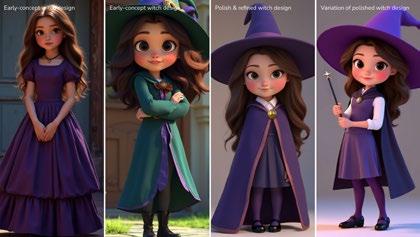
Included in a smartly configured Craftsman case are two styles of rigging plates to expand mounting options. The Standard MICROGrip Plate features multiple evenly spaced nail and screw holes, making it ideal for mounting into wood or building tabletop, podcast or small-scale camera, light or microphone rigs. The MICROGrip Nail-On Plate includes a unique T cutout that fits between the plates of the MICROGrip Head, adding articulation and positioning flexibility.
The 148-piece MICROGrip Master Rigging Kit is now available from Matthews dealers worldwide.
❚ www.msegrip.com
To help filmmakers and content creators deliver more quickly and efficiently, Dimension Studio has developed a new end-to-end artificial intelligence content production pipeline. “When using AI tools for content generation, the control and consistency from shot to shot has been one of the biggest challenges,” Dimension Studio chief innovation officer Junaid Baig said. “What our team has been able to do is to systematize how tools are used to enable consistent results for characters and environment, and to maintain control of assets between shots for things like camera movement or animating multiple characters at once.”
The company’s Dimension Futures team, which designed the solution, has also produced the animated short “Mara & Milo: Magic & Mayhem” to showcase the solution’s capabilities. The pipeline allowed the artists to accelerate creative and look development and to deliver the finished production in weeks rather than months, the company said. ❚ dimensionstudio.co
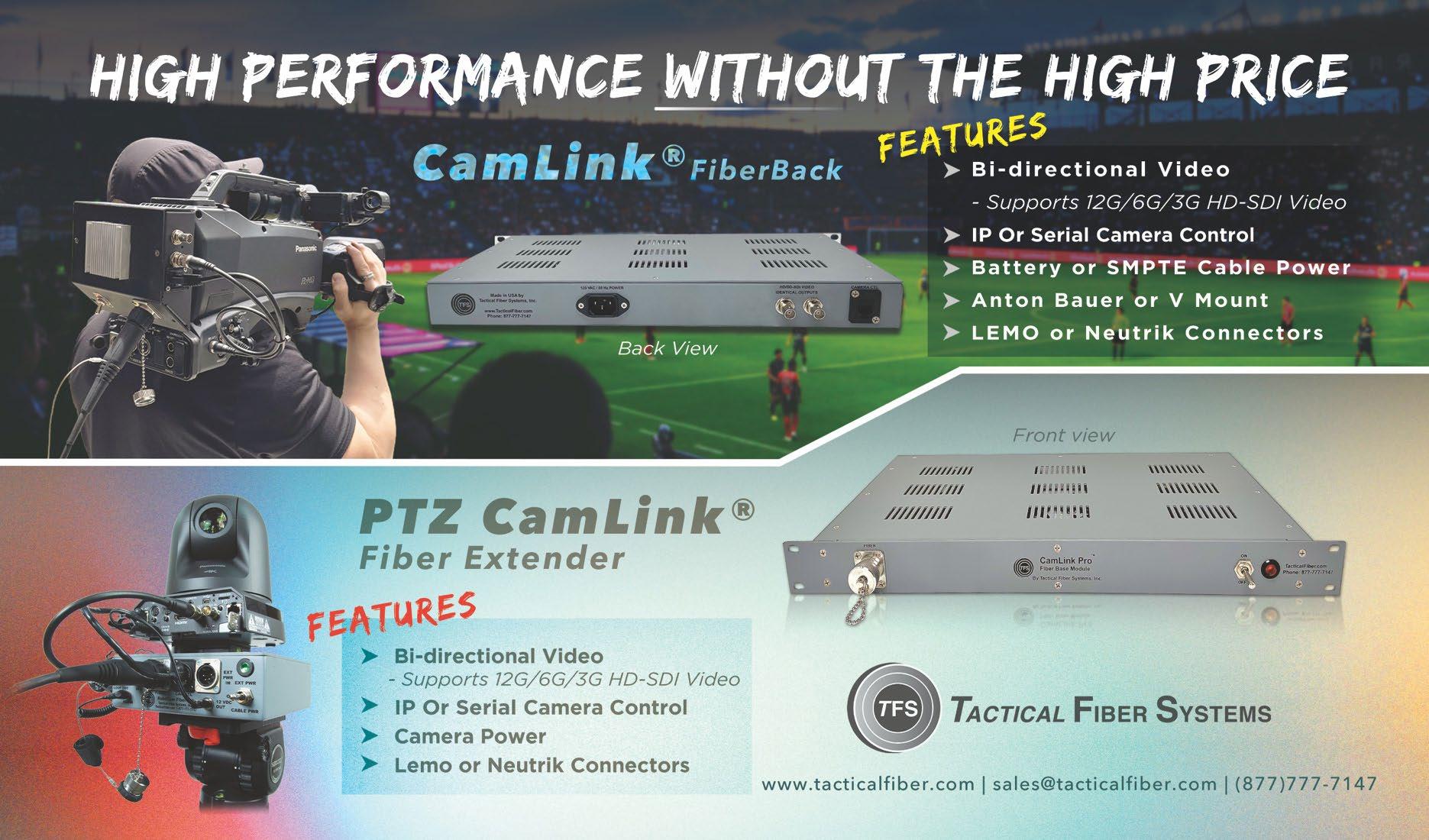
By Joey Verrett Director of Operations WBRZ-TV
BATON ROUGE, La.—As the ABC affiliate for Louisiana’s capital city, WBRZ-TV is one of the few remaining broadcast network affiliates under local ownership. In Baton Rouge, WBRZ is also the longest-running VHF station on the air, having operated at each bookend of the spectrum over its seven decades of broadcasting.
Launched on Channel 2 in 1955, WBRZ moved to RF Channel 13 after the digital TV transition in 2009, installing a new side-mounted, high-band Dielectric VHF DTV panel antenna. With no immediate need for removal, the top-mounted, lowband analog antenna installed in 1962 was decommissioned and left in place.
Nearly 15 years later, we reclaimed that real estate for ATSC 3.0 and installed a new top-mounted Dielectric THV pylon antenna to accommodate ATSC 1.0 and 3.0 broadcasts from the same single-channel stick. Radiating from a height of 1,035 feet, the antenna has already made a positive impact with both viewers and our RF performance.
We worked closely with Bo Hoover, president of TSG, on the antenna design. Bo brought in other specialists to ensure a thoroughly professional job, including Kessler and Gehman (pattern envelope study), Hodge Structural Engineering (tower modifications) and Fullwave Tower and Broadcast (antenna installation).
We submitted the results of Kessler and Gehman’s study to

the Dielectric engineering team, who tailored the pattern and maximized the envelope while maintaining the original center of radiation. The study also confirmed that WBRZ qualified for a potential power increase, which in the end raised our effective radiated power (ERP) to 30 kW.
The THV was specified as a six-layer design with a significant vertical polarization element, which has improved penetration to indoor antennas. The vertical element will also benefit our ATSC 3.0 coverage, including delivery to mobile devices. The top-mounted position is 300 feet higher than the panel, which has transitioned into backup service. The antenna’s directional pattern points at 130 degrees toward the New Orleans market to optimize audience reach. Collectively, we
have added more than 150,000 households since raising the new antenna.
Raising that antenna required a substantial amount of work—the original one-piece, top-mounted stick was broken into three sections to ensure safe removal. Each section was lowered with a gin pole along with the old socket and the panel antenna was removed and run through a temporary dummy load to ensure on-air continuity.
The Fullwave team installed a new top plate and socket prior to raising the THV system. Dielectric also supplied a transmission line and a new Channel 13 filter, the latter of which TSG installed along with a new transmitter.
We are seeing exceptional performance from the entire system. Our VSWR system per-
formance borders on immaculate, with only 4W of reflected power coming back through the transmission line from the THV antenna. The antenna itself is only using 6.5 kW of its 30 kW power rating, leaving plenty of headroom for NextGen TV services.
These are all indicative of Dielectric’s robust engineering and attention to detail, which also includes a full lightningprotection halo to withstand our region’s intense electrical storms. We’re confident this antenna will not only deliver excellent performance, but the longevity broadcasters count on when bringing a new antenna system to life. ●
Joey Verrett is director of operations at WBRZ-TV. He can be reached at jverrett@wbrz.com
More information is available at www.dielectric.com
REPORT
By Marlowe Taylor Production Sound Mixer CAS, AMPAS
CLEVELAND—“Fear the Walking Dead,” a spinoff of AMC’s original series “The Walking Dead,” explores the early days of the zombie apocalypse from a new angle, offering fresh characters, locations and narrative challenges. The show takes a Los Angelesbased family and drops them into the terrifying unknown, forcing them to navigate a world quickly spiraling into chaos.
For those of us behind the scenes, this means meeting the creative ambition of the series with equal technical innovation. As the show evolved, so did our production requirements—especially in the audio department.
As a proud member of the Cinema Audio Society (CAS) and the Academy of Motion Picture Arts and Sciences (AMPAS), I am deeply committed to pushing the boundaries of what’s possible in production sound. I constantly seek out solutions that deliver clarity, reliability and flexibility, especially on complex sets. That’s exactly what I found with Wisycom’s fiber system: simply put, it’s a game-changer. The zero signal loss, consistent clarity and adaptability in a range of shooting conditions have completely transformed how I operate on set.
On “Fear the Walking Dead,” we often faced unique production challenges such as wide establishing shots, mobile camera work and set designs that demand cart placement far from the action. Traditional RF systems struggle under these conditions;
the further you run coaxial cable, the more signal degradation you encounter. I needed something that wouldn’t compromise on performance no matter the terrain or distance.
That’s where Wisycom’s BFLT2 and BFLR2 RF-over-fiber modules came into play. Paired with dual-diversity antennas and tactical fiber, I was able to extend my reach to nearly 1,000 feet without any signal loss or compromise in audio quality. The system is completely plug-and-play and brand-agnostic, which means I can integrate it seamlessly with any equipment I’m using. That level of versatility is rare and incredibly valuable in the fast-paced world of film and TV production.
One particular moment that stands out to me was when we needed to capture audio from a valley with antennas placed high on a hill. What would have taken hundreds of feet of coaxial cable, active antennas and calculations for gain stages to overcome signal loss was now accomplished with a single 150-foot run, no gain required. With filters in place and Camplex-tough tactical fiber cables running through the mud, the RF system performed flawlessly. This was another mission success.
Another example involved placing the cart around the corner of a large building, with no line of sight. Again, the Wisycom system delivered flawless RF

signals, proving its reliability regardless of location or physical barriers.
What also sets this system apart are its advanced control and integration features. From my cart, I can monitor and adjust settings via Bluetooth or Ethernet. That means I can change the gain, assign channel names and manage frequencies without leaving my sound rig. It gives me full visibility and control—no guesswork, no running back and forth.
The affordability and ease of use make this a compelling option not just for high-end productions but for sound mixers across the board. I’ve been so impressed that I regularly share my experiences with fellow professionals, including renowned mixers and other sound experts at industry events like NAB Show. I’ve had colleagues stop me just to ask how I’m achieving such clean results in tough locations. The answer is always Wisycom.
For anyone serious about audio in production, especially in the unpredictable conditions of modern filmmaking, the Wisycom wireless fiber system is more than just a tool—it’s a solution. For me, it’s one I now consider essential on every set. ●
Marlowe Taylor is a production sound mixer with 30-plus years of professional experience spanning music, film and TV. His transition from the recording studio to production sound led to an extensive portfolio of projects with studios like Disney, Universal, Lionsgate, Paramount, AMC and more. Contact him at 216-256-8787 or mtsoundmixer@gmail.com
For more information, visit https://wisycom.com
REPORT
By Brent Clingingsmith Chief Technology Director, Engineering, WGEM-DT
QUINCY, Ill.—During its 72 years on the air, WGEM-DT has continuously operated through several transitions, including ownership and network affiliate changes. Licensed to the city of Quincy, Illinois, we had been operating from a broadcast tower situated in a residential neighborhood.
Seizing the opportunity to relocate, we shifted to a shared tower site that has allowed us to take better advantage of our 1 MW of effective radiated power (ERP). In addition to an improved tower position and better sight lines, the move also laid the groundwork to move from VHF Channel 10 to a UHF frequency.
Now broadcasting over UHF Channel 19, these changes have improved coverage to the north and east for WGEM—Quincy’s NBC affiliate—adding three counties to our DMA, while blanketing populated areas such as Burlington, Iowa, that were difficult to reach.
The move to UHF also required an entirely new RF infrastructure. As WGEM is based in Quincy, we naturally have a strong relationship with GatesAir, which operates its manufacturing center here. About seven months ago, we installed a Maxiva ULXTE-80 UHF transmitter along with a new antenna and combiner, all working together to power our 46 kW TPO with exceptional performance.
The transition to UHF, which included a power increase, also marked our introduction to a
liquid-cooled operation. This required a substantial redesign of the existing plant to house new filters, transformers and pump modules, along with the ULXTE transmitter. GatesAir engineers helped design the system to ensure it was up and running, and properly functioning, within our tight timeline.
Moving from air-cooled to liquidcooled does require a learning curve. Where air-cooled systems are mostly dependent on consistent air conditioning and proper circulation, liquid-cooled systems bring together chillers, pump modules, valves and tubing that circulate coolant to keep high-power transmitters cool and operating consistently, with outdoor air handlers to efficiently expel heat from the room.
more activity, keeping our skill sets sharp while being far from an engineering burden.
The ULXTE transmitter is equipped with dual Maxiva XTE exciters. During maintenance, we switch to the secondary exciter to
over-the-air signal coming out of the transmitter. The exciters also include GatesAir’s RTAC real-time adaptive correction technology to eliminate frequency drift and remain within our RF 19 specifications.
Its GUI, along with the transmitter’s GUI, providing us with
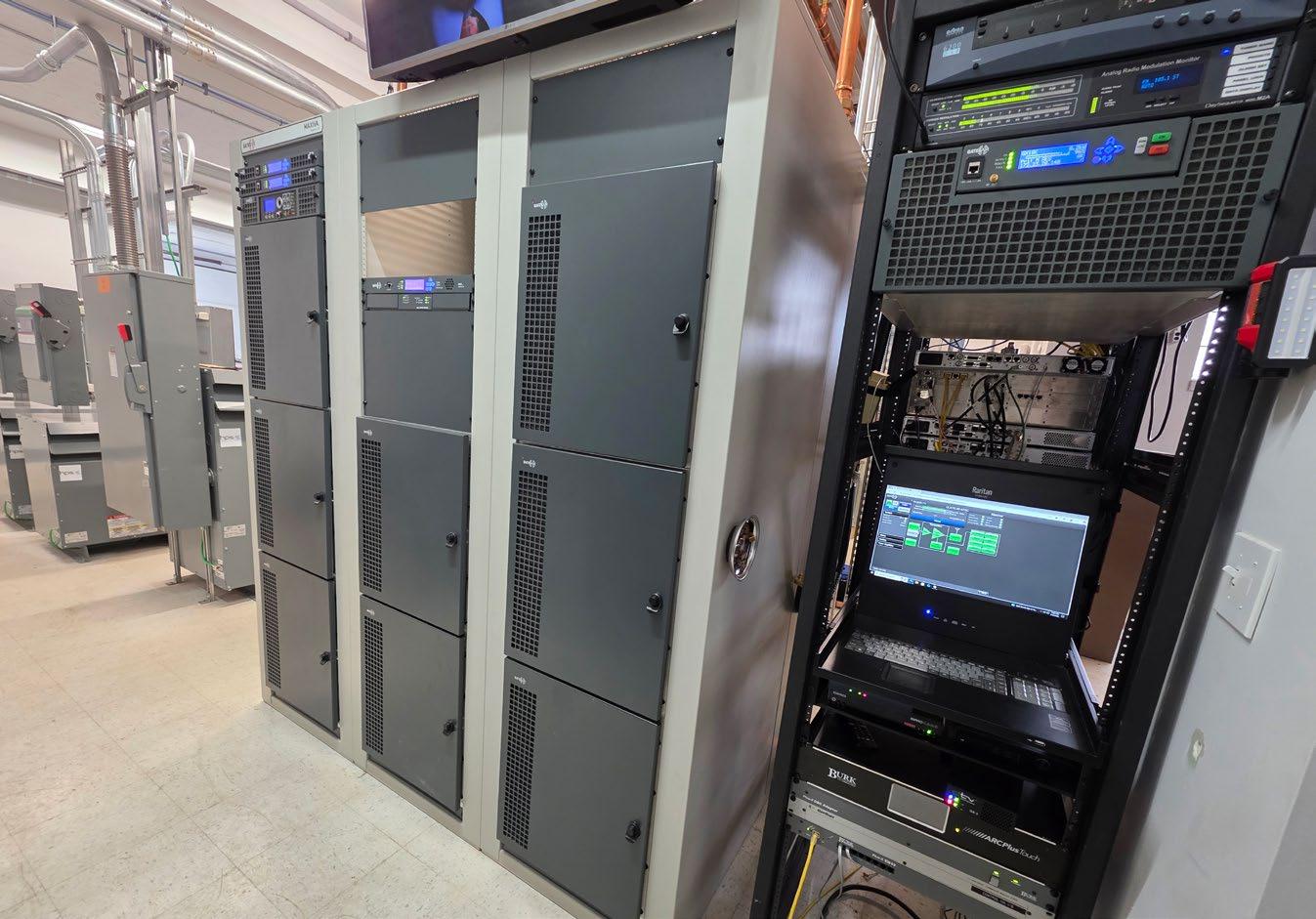
GatesAir’s solid-state liquid architecture is fully modernized with a sensible workflow that helped us quickly adapt. That comfort level soon extended to system maintenance, which includes a biweekly review of pump and flow pressure (40 psi), power levels and alarm thresholds to confirm operational stability.
We occasionally add coolant to the system, which requires a complete flush every three to four years when the hue of the existing liquid turns green. While this technically adds up to more maintenance than an air-cooled system that requires quarterly maintenance, working with a liquid-cooled system invites
ensure system redundancy is in order. With no backup transmitter in place, the redundant exciter architecture is an important fail-safe for on-air operations, with automatic switchover when needed.
Like GatesAir’s air-cooled transmitters, the ULXTE liquid-cooled solid-state infrastructure features amplifiers and power supplies that are quick to replace. For liquid systems, the transmitters are carefully designed to prevent leaks and damage upon removing and placing a module.
The XTE exciters reliably take in and amplify our DTI and ASI signals to produce a robust
all the monitoring intelligence we need to ensure our power level, modulation error ratio and other readings are clear, accessible and within approved thresholds. And with NextGen TV broadcasts on the horizon, the XTE also provides a direct path to the ATSC 3.0 standard via a firmware update. ●
Brent Clingingsmith is chief technology director, engineering for WGEM-DT and oversees all engineering, maintenance and repair operations across master control, RF, & systems. He can be reached at BClingingsmith@wgem.com
More information is available at www.gatesair.com
By Dr. Jamey Schmitz Founder & President/CEO WLMB-TV 40, YES-FM Radio Network
TOLEDO, Ohio—At WLMB-TV 40, our mission has always been to serve Northwest Ohio and Southeast Michigan with familyfriendly, devotional programming. Since our founding in 1998, we’ve worked hard to deliver high-quality content while being careful stewards of our resources
profit organization, we had to ensure that every dollar spent would provide strong value for our community.
We raised the necessary funding through an on-air donation drive, knowing our viewers trusted us to invest wisely. Our next step was finding a transmitter that could maximize efficiency, reduce operational costs and support our long-term goals. We conducted extensive research, spoke with respected broadcast
questions promptly and providing clear technical information whenever needed. That level of responsiveness gave us confidence not only in the product but in the partnership itself. For a smaller, mission-driven station like ours, having direct access to knowledgeable support was especially important.
After a thorough review, we chose the Rohde & Schwarz R&S TE1 liquid-cooled transmitter. Its energy-efficient design stood out immediately. Liquid cooling significantly reduces the need for energy-intensive air conditioning, lowering overall energy costs. As we calculated projected savings, we realized the R&S TE1 would pay for itself within three to four years—a critical factor in our decision.
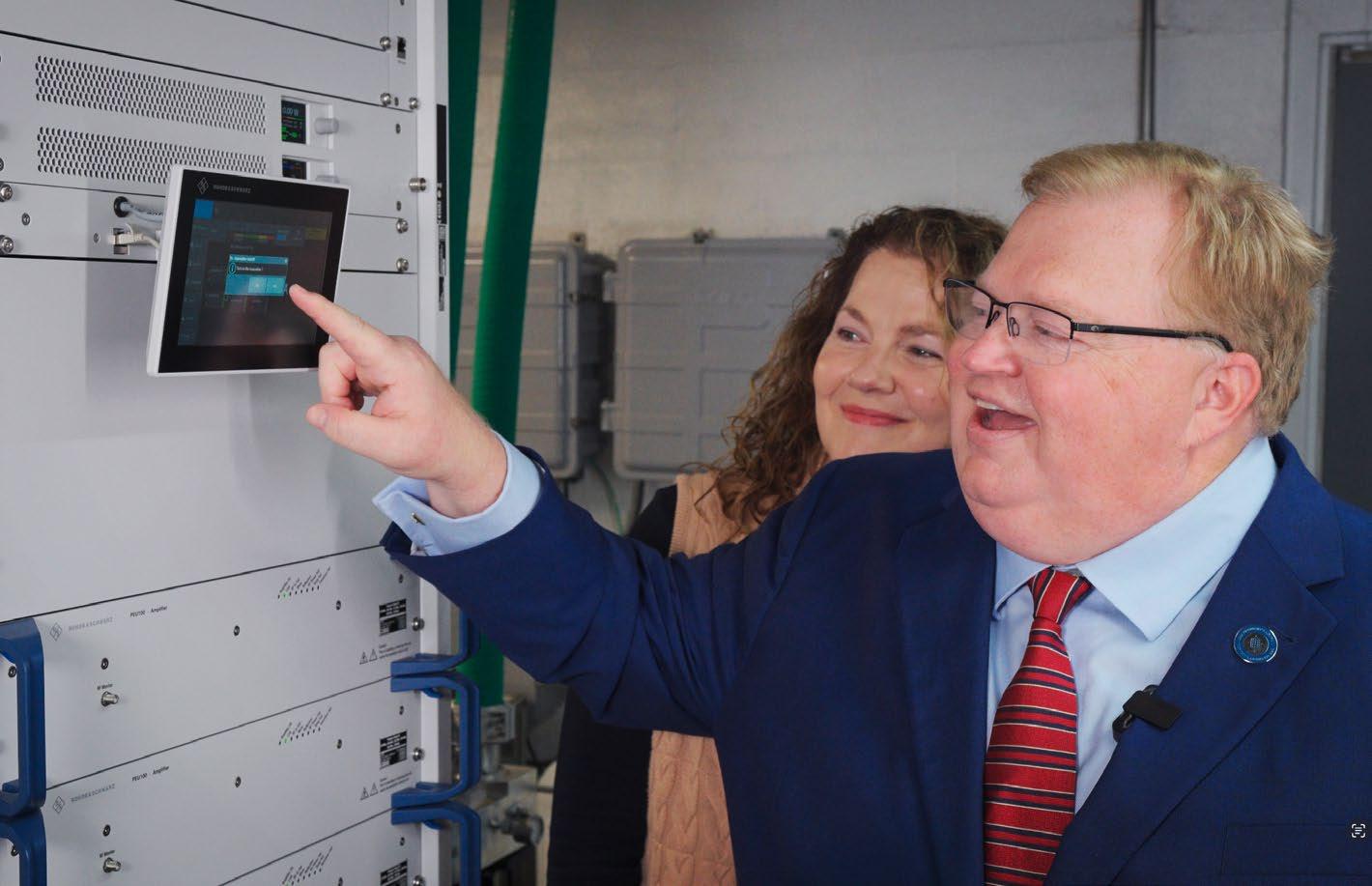
as a nonprofit broadcaster.
When we won a bid for UHF Channel 35, we faced a major transition: We needed to move from the VHF band to UHF, requiring a higher-frequency transmitter capable of delivering increased power. This was not just a technical upgrade; it was an opportunity to expand our audience reach and improve broadcast quality. But as a non-
engineers and met with manufacturers at trade shows.
In addition to performance and efficiency, service and support played a key role in our decision. Rohde & Schwarz provided excellent presale guidance and remained engaged throughout the installation process. Its team worked closely with our engineers to ensure a smooth and timely transition, answering
The installation of the transmitter took approximately two weeks. Since going live with the R&S TE1, we have seen a remarkable 28% increase in audience reach, expanding from 1.8 million to 2.3 million households, with half of those households able to receive our signal with a simple indoor or outdoor antenna. Additionally, about 1.24 million people in neighboring TV markets can now more easily receive our signal.
Beyond energy savings and expanded reach, the R&S TE1 has
positioned WLMB-TV for the future. It is ATSC 3.0-ready, ensuring that when we decide to adopt next-generation broadcast technology, we’ll be prepared without needing another major equipment investment. For a nonprofit like ours, this future-proofing offers both financial security and strategic flexibility.
Reliability was another major factor in our choice. With any broadcast operation, equipment downtime can impact not just technical operations but the trust we’ve built with our viewers. Knowing that the R&S TE1 is designed for high reliability and a long service life gives us peace of mind that we can continue serving our community without interruption.
Looking back, selecting the R&S TE1 was the right decision for WLMB-TV 40. We have improved the quality of our broadcasts, expanded geographic reach, significantly reduced operational costs and set the stage for future growth—all while staying true to our commitment to be responsible with our donors’ support.
The transition from VHF to UHF could have been a daunting and expensive undertaking, but with careful planning and the right technology partner, it has been a tremendous success for our station and the community we serve. ●
Dr. Jamey Schmitz is the founder, president and CEO, WLMB-TV 40 and YES-FM Radio Network. Schmitz has dedicated his career to promoting Christian values and programming through the station’s diverse range of shows and community outreach initiatives. He can be reached at jschmitz@wlmb.com
For more information, visit www.rohde-schwarz.com
USER REPORT
By Lou Pantoja Senior Director, Live Production FloSports
AUSTIN, Texas—FloSports is a U.S.-based sports media company that specializes in live and on-demand streaming of more than 25 underserved sports to hyper-passionate fan bases.
As senior director of live production at FloSports, part of my role is to ensure we deliver a quality product to our viewers, and a big part of that is transmission quality and stable contribution streams. In the early days, internet bandwidth made this challenging and we didn’t have nearly the scale we do now. Last year, we streamed more than 40,000 live sporting events including all of the stick-andball sports along with wrestling, grappling, track and field, motorsports, cheer competitions and tons of collegiate athletics.
Our customers aren’t necessarily interested in all the sports that we stream, however. They’re interested in their sport and a particular game. They expect a good quality on-air product and they don’t necessarily care how it gets there.
With that in mind, reliability in production is something that is critical to our operations. Given the wide variety of events we stream, there is a split between those produced by our partners and those produced by our team. Until recently, most of the events we produced ourselves were handled completely on-site, but in recent years, we started to incorporate REMI production coverage. In both

life—less travel and less time on the road means more time at home, which is beneficial for everyone involved in our productions.
these instances, that is where TVU Networks comes in.
Our relationship with TVU started because we were seeking a backup transmission solution that didn’t need to rely on a standard internet service provider. We needed a way to send high-quality, composited audio and video back when ISPs didn’t work well or when we didn’t have enough bandwidth. To maintain uninterrupted live coverage, we deployed TVU One mobile units as backups where our contribution feed started, ensuring resilience against potential connectivity issues.
After we realized the success of integrating the units and the benefits we were seeing—ultralow latency, ease of use, reliability and seamless integration with the TVU ecosystem—the partnership grew significantly.
Now, we’re doing REMI productions with TVU, utilizing its IP-video solutions to produce
live programming from remote venues, such as a cross-country course or dirt racing track, where traditional broadcasting infrastructure may be lacking. We’ve also started moving more to the cloud, utilizing TVU Producer to produce live events remotely. This offers us plenty of flexibility as we bring everything back inhouse to our facility in Austin to put it all together.
The most obvious benefit we see with TVU is efficiency; we want to save money where we can without compromising the quality of the product we put out. TVU definitely offers flexibility when it comes to REMI workflows, which in turn allows us to bring production in-house, where we can maintain consistent crews who know our gear and workflows. This also has an impact on our team’s quality of
Today, TVU has become a foundational piece of how we are evolving as a production company. In this business, consistency is everything: consistent streams, consistent quality, consistent crews. The flexibility we’ve gained by using TVU’s IP and cloud-based tools has allowed us to rethink how we cover live sports—not just in terms of cost and logistics, but also in terms of people. We can focus on building long-term teams and workflows that grow with us while still delivering the kind of seamless, high-quality viewing experience that our audiences expect.
As we continue to expand and refine our production capabilities, partners like TVU are instrumental. They don’t just just help keep us up to date with the tech, they also help us lead, which, in turn, keeps our customers happy. ●
Lou Pantoja, senior director, live production, FloSports, is a veteran television director and operational leader with a focus on the growth and quality of live event and studio based sports productions. Before Flo, Pantoja led production teams at SNY, ESPN and Fox Sports. He can be reached at 310-210-2721 and lou.pantoja@flosports.tv For more information, visit www.tvunetworks.com
By Cody Richardson Founder Creative Illusion
GOLD COAST, Australia For more than a decade, the Australian-based co-production involving A Suite Production and Creative Illusion has delivered production services for the annual World Ocean Series (WOS). During that time, we have played a key role in helping the event successfully grow its media output from a simple live wirecast to Facebook and YouTube into a high-quality, livestreamed production distributed to multiple OTT platforms, including 7Plus, Kayo Sports and TVNZ+.
From November to February, we spend 10-plus production days on the beaches of Queensland, New South Wales, Victoria and
South Australia livestreaming the WOS, where elite surf sport athletes from across the globe participate in the Ironman-style tournament.
Beach environments are tricky terrains—the heat, rain, sand, salt and ocean mist take a toll on equipment. In the early days, we would set up camp with a Windows PC running off a generator and run cables to a single drone and a few “lock-off ” static cameras. It wasn’t unusual to have issues with the gear or for computers to overheat During our first season, we even misjudged the tide in one location and the director ended up ankle deep in water for the entire live stream.
That forced us to reimagine our approach. For the following few series, we decided to hire an OB truck to keep the majority of equipment out of the elements. It
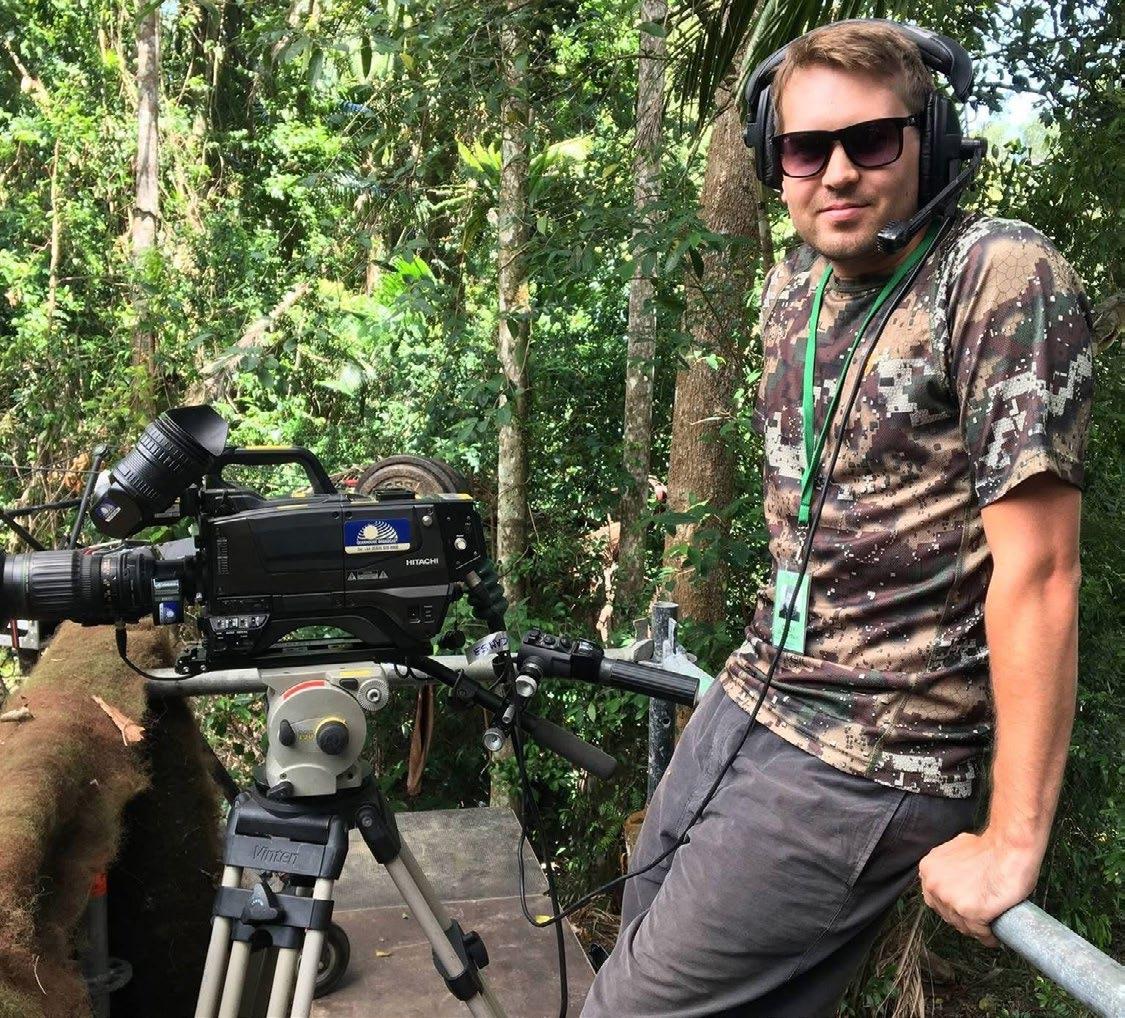
was the right thing to do to increase production value and mitigate equipment failure—but the cost and time spent transporting the truck and the crew, coupled with the laborious task of digging trenches for cables, became a significant burden.
Two years ago at a WOS event in Manly, near Sydney, a couple of unfortunate incidents highlighted the vulnerabilities of that approach. After a 900mile truck journey and another long cable-trench dig along the beach—from the car park to the starting line and commentator platform—an overnight street sweeper accidentally destroyed our fiber lines.
In a panic, we managed to rerun the cables but then, just before airtime, the event was canceled due to sharks in the water. The event organizers had already paid for the OB truck, the crew’s wages and their accommodation and flights. It was a major loss.
That’s when we decided to leverage Dejero Smart Blending Technology and implement an all-remote, cable-free production workflow.
We now deploy Dejero EnGo mobile video transmitters for our live camera feeds. Each EnGo is equipped with six SIM cards that aggregate signals from multiple carriers. These powerful units blend any IP network (3G/4G/5G, Wi-Fi, LEO/MEO/GEO satellite and broadband) and seamlessly incorporate Starlink when needed in remote locations.
The benefits of the solution have transformed our production by eliminating expensive OB truck rental and transportation and enabling remote production with our home-based control room. Our remote workflow
centers around a central control room where a Dejero WayPoint receives the EnGo feeds.
Producers, directors and graphics operators do not need to come on-site They do switching, replays and add graphics remotely, then we send everything down to master control via the Dejero feed. Commentary teams use a multiviewer to monitor all feeds in real time and we utilize EnGo’s IFB voice communication for director-to-camera operator communication.
The Dejero equipment has not only streamlined our operations but also enhanced our production quality; we’ve achieved increased mobility, sub-second glass-to-glass latency and superior picture quality. Client feedback has been overwhelmingly positive, with viewers noting a marked improvement in quality, which has attracted more event sponsors.
We’ve just wrapped our second season using this Dejero-centric workflow and the results speak for themselves: lower costs, reduced stress and higher-quality broadcasts. Our next innovations include jet ski cameras and additional drone feeds—continuing to push boundaries in live sports broadcasting from challenging environments. ●
Cody Richardson is the founder of Creative Illusion. As a cameraman, some of his credits include “Big Brother Australia,” “I’m a Celebrity … Get Me Out of Here! U.K ,” “Outback Truckers” and “Bachelor in Paradise.” He also works within the outside broadcast world, for NEP/Gravity as well as smaller independent OBs and live streams. Richardson can be reached at cody@codyrichardson.com
For more information, visit www.dejero.com
With QuickLink StudioEdge, broadcasters and production teams can seamlessly introduce remote guests from every major video-conferencing platform—including Zoom, Microsoft Teams and StudioCall—into productions, optimized with AI technology from NVIDIA. With Skype reaching its end of life, many production teams are seeking alternative solutions to maintain seamless remote guest integration. StudioEdge supports four channels of broadcast-quality discrete audio and video from remote guests. It can be seamlessly integrated into the production suite via SDI, NDI and other broadcast inputs/outputs.

The HCAM high-performance wireless camera system offers unparalleled flexibility and cutting-edge technology. With user-interchangeable RF modules and a wide range of software options, HCAM is designed to meet the diverse needs of today’s broadcast and live-event environments and is compatible with a variety of camera types, including broadcast cameras for sporting events, ENG cameras for newsgathering and prosumer cameras, providing users with application flexibility.

In addition, production teams using StudioEdge no longer need several solutions, as StudioEdge unites disparate, competing technologies into a single, easy-to-use system. StudioEdge allows users to create real-time group conversations, panel discussions and live interviews with direct communication and chat support for guidance. www.quicklink.tv
Haivision Pro mobile video transmitters are designed for low-latency reliable live video contribution over bonded cellular and IP networks from anywhere. Ideal for sports TV, live event production and newsgathering, the Haivision Pro series offers a range of easy-to-use options.

HCAM is also at the forefront of the transition from OFDM to 5G technology for live-event deployments. By integrating the optional HCAM Module 5—a 5G edge device for Vislink’s HCAM OFDM systems—users can harness 5G to enhance creativity and operational flexibility. This allows for a smooth transition to 5G at your own pace.
www.vislink.com

With a portable form factor designed for use on-camera mounts or backpacks, the Haivision Pro family of mobile transmitters offers a range of configurations—from single to quad-HD and 4K UHD video encoding with four, six or eight internal modems for reliable transmission over 3G, 4G and 5G networks. It also offers premium live video broadcasting over cellular and IP networks: 3G/4G/5G, Ethernet, and Wi-Fi, as well as BGAN, GX, Ka and Ku bands over satellite. Other features include: video returns and intercom; camera remote control; pristine HD video over 5G; premium 4K UHD live transmission and multicamera synchronization. www.haivision.com
A highly versatile and efficient 1U encoder and decoder, the LiveU Transceiver allows users to share and receive up to four video feeds simultaneously from contribution and distribution sources via a single device. It includes a built-in switchable configuration with four flexible in/ out SDI interfaces (3G/HD-SDI) and can be used as an encoder, a decoder or both simultaneously, with the freedom to adjust it easily to your production needs.

MultiDyne’s VF-9000 is a 1RU fiber optic transport platform with SNMP monitoring. The highdensity unit offers a reliable signal transport solution for intrafacility connection, such as moving TV program signals from the studio to a transmitter site. Other use cases include interfacility connections, sports broadcasts, ENG and any studio or mobile truck application where space is limited. Dual hot-swappable power supplies ensure optimal power redundancy.
The VF-9000’s high-density design includes 18 or 36 optical I/O (9 or 18 SFP Ports) and can be configured with up to 18 full-size BNCs or 36 HDBNCs. If populated with CWDM SFPs, all 36 signals can be multiplexed or demultiplexed over/from two SM fibers. A forthcoming update will include a new frame controller and a restful API to enhance integration, monitoring and control. www.multidyne.com
The LiveU Transceiver complements the LiveU Matrix solution, serving as a combined contribution and distribution solution—letting users simplify operations and widen their reach. It is also ideal for various scenarios of point-to-point contribution. It leverages the LiveU Reliable Transport (LRT) protocol to dynamically send or receive up to four parallel 1080p video streams. The flexible encoder/decoder configuration allows you to repurpose the unit for your specific production type. www.liveu.tv

For possible inclusion, send information to tvtechnology@futurenet.com with People News in the subject line.

Carlo DiMarco has joined USSI Global as vice president of strategic marketing and growth, with responsibility for strategic business development in the network, broadcast and digital signage solutions provider’s new and existing markets. Based in New York, DiMarco has a background in strategic growth and technology at Paramount Global/Viacom, Cheddar News and most recently at digital outof-home startups in the point-ofcare space.
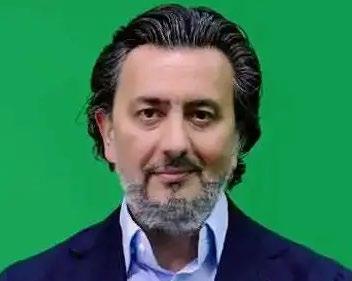
Baris Zavaroglu has joined Amsterdam-based virtual studio productions and on-air graphics provider Zero Density as CEO. Succeeding Ofir Benovici, who left the CEO role at the end of 2024, he’ll lead the executive team and oversee the company’s continued global expansion. Zavaroglu brings more than two decades of experience in management positions at HBO Max, Turkcell, TV+, Merzigo, Veon, Fox and The Walt Disney Co., with a background in OTT, pay TV, linear TV, AVOD and FAST markets.
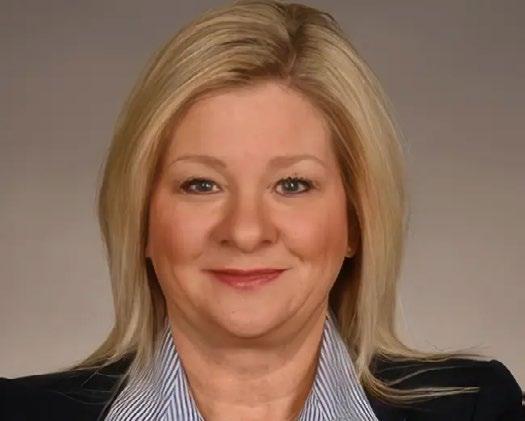
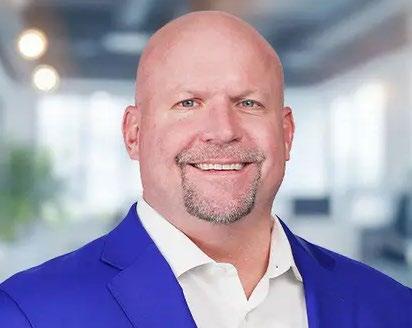
Gray Media has promoted Dana Neves to senior managing vice president, overseeing markets in the Northeast and Mid-Atlantic regions. For the past seven years, Neves was general manager of Gray-owned CBS affiliate WFSB in Hartford, Connecticut. She also led Connecticut-focused sports network The Wax. Neves began at WFSB as an intern and rose through the ranks, serving as news director, regional news director, general manager, and senior VP for its previous owner, Meredith Corp.
Chris Fulton has been promoted to senior vice president, customer operations and experience at Spectrum Business, the commercial services unit of Charter Communications, responsible for technical support, customer service, service delivery and billing for Spectrum Business subscribers across the cable operator’s 41-state footprint. He had been regional vice president of field operations for Spectrum’s Northwest Region, heading field operations for cable systems in nine states.

